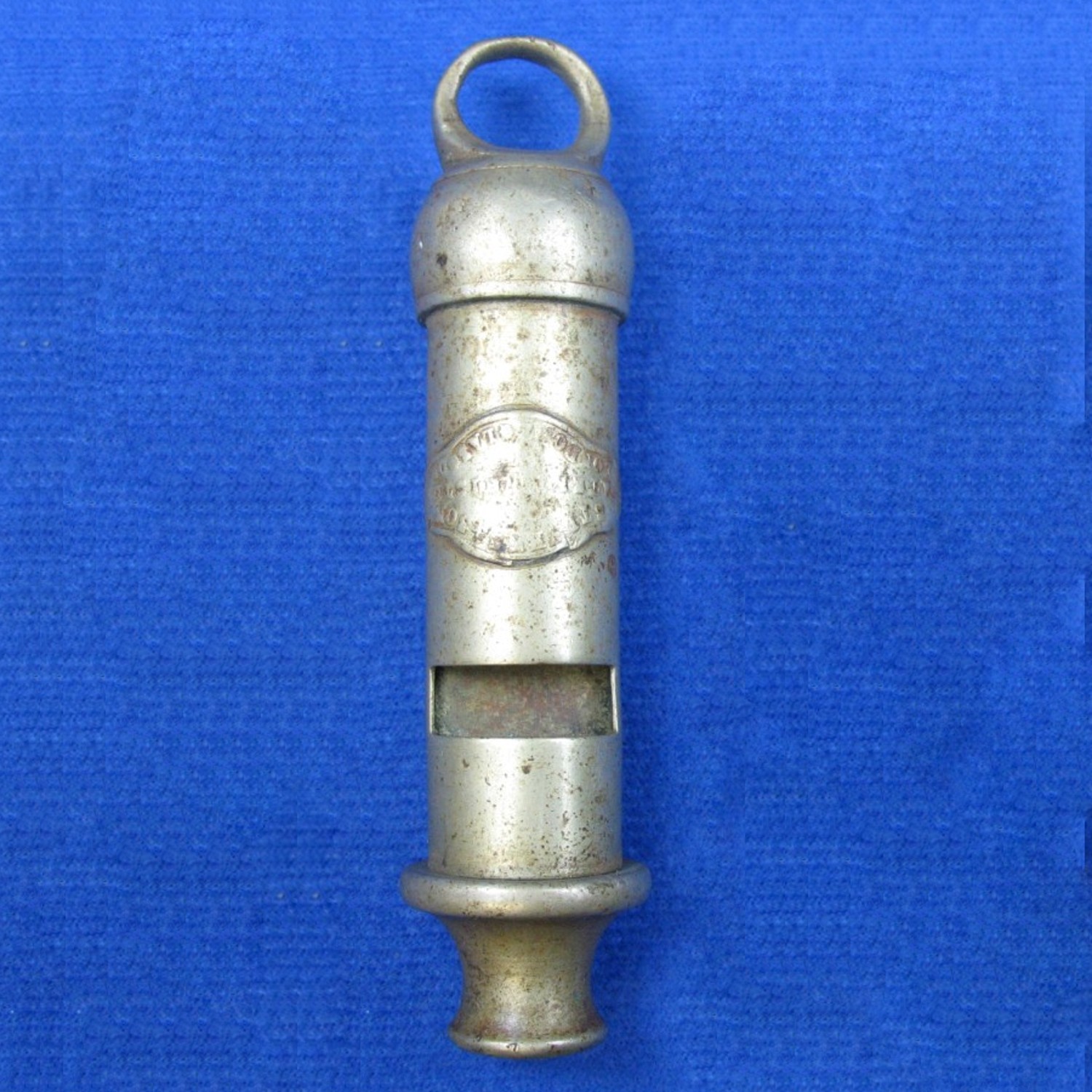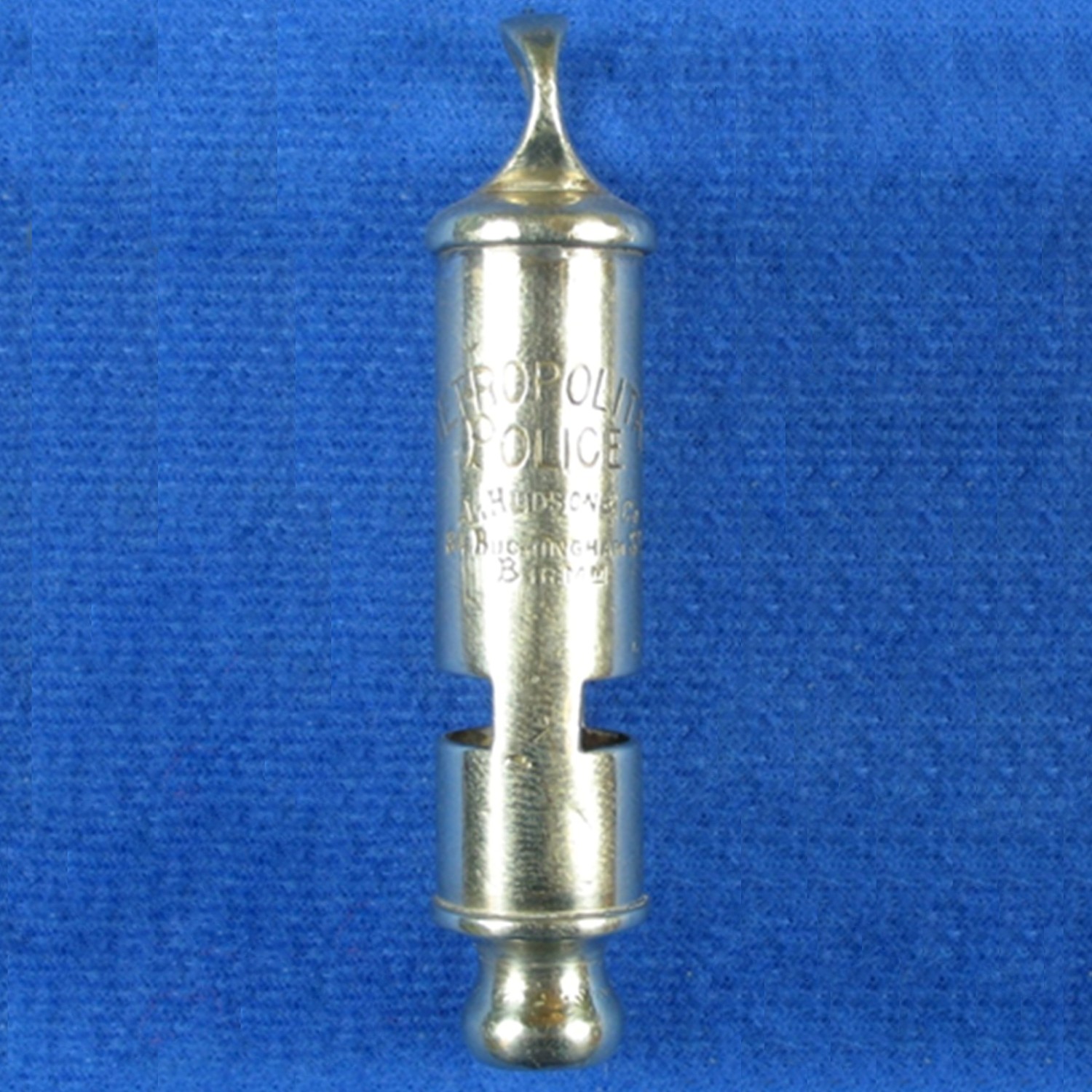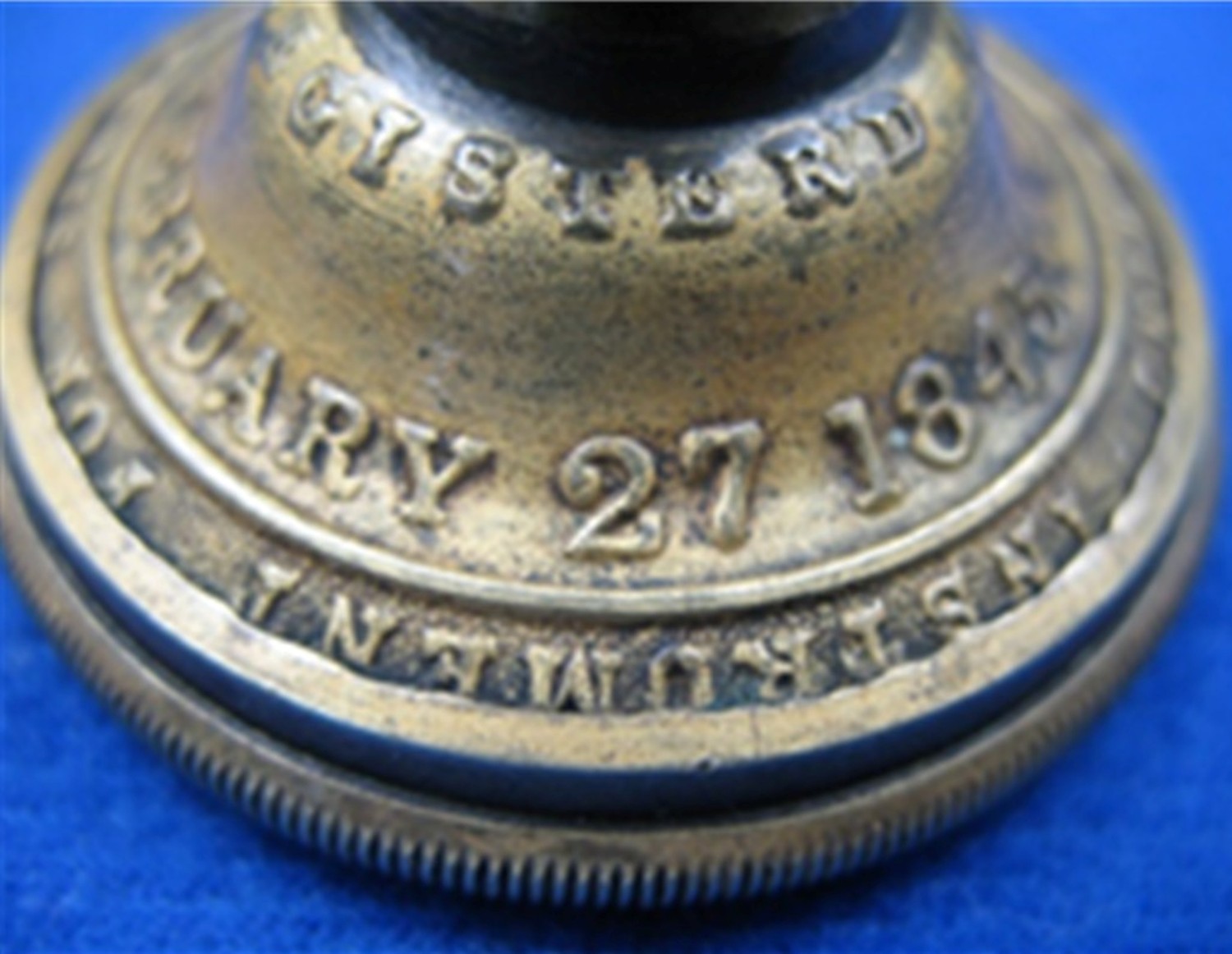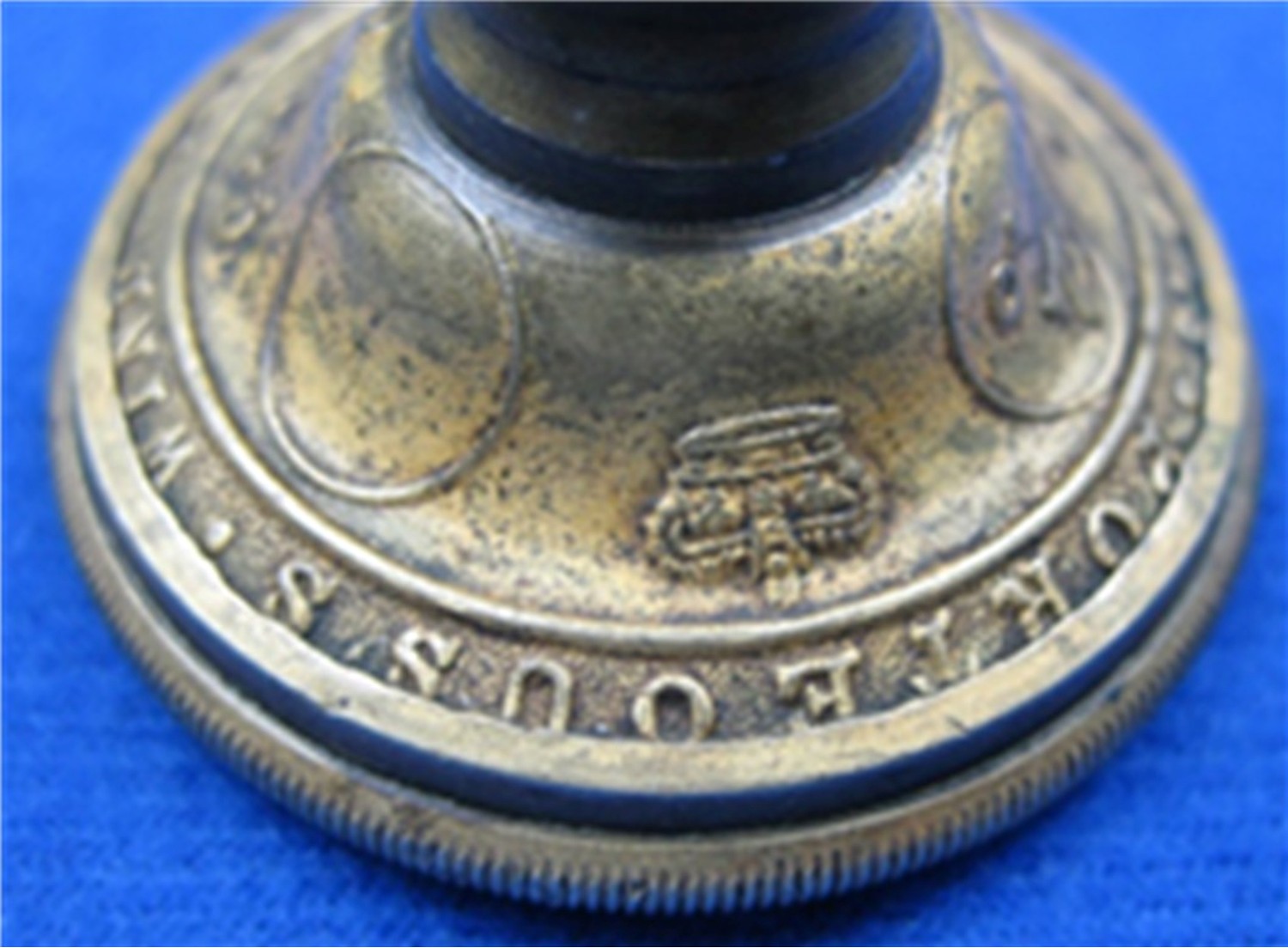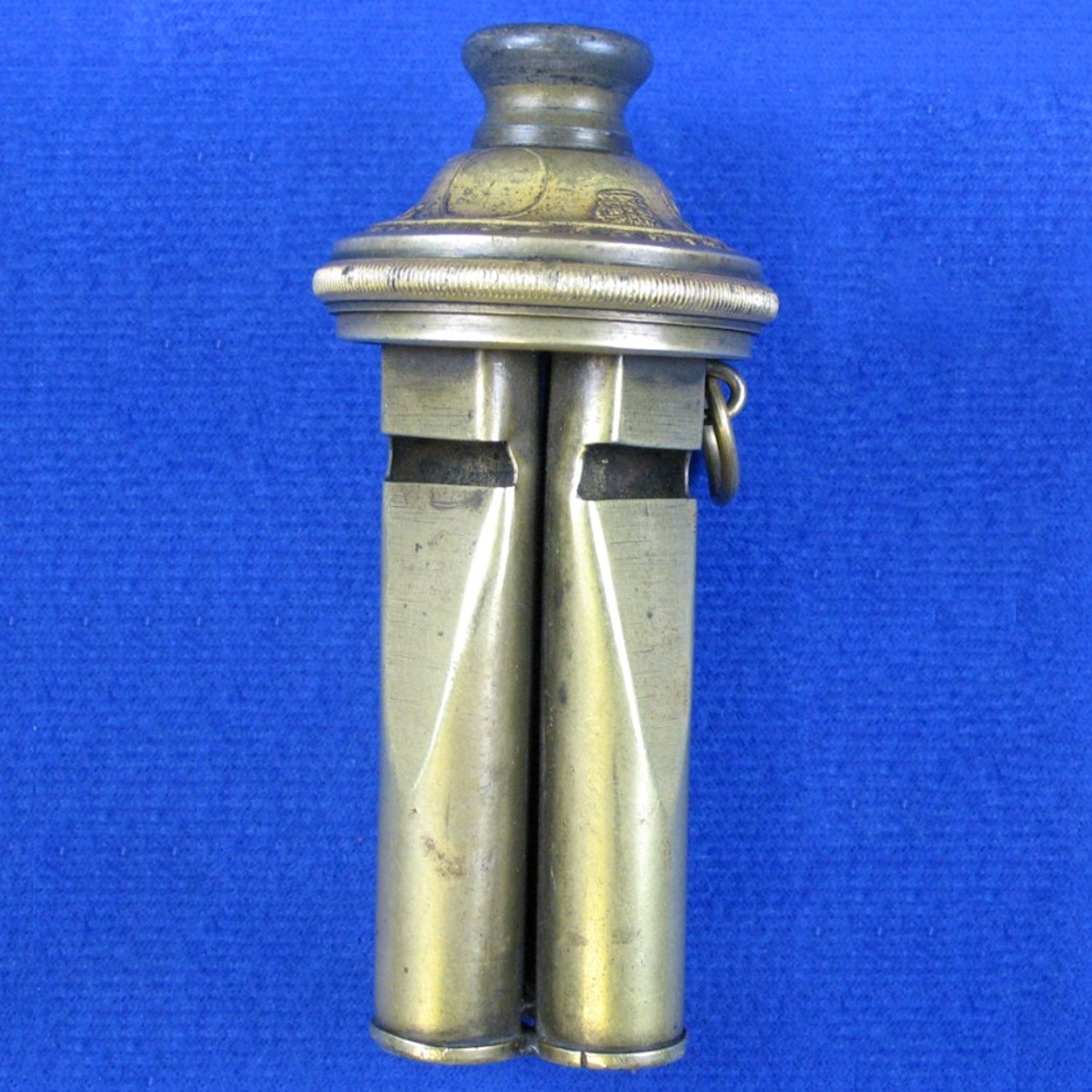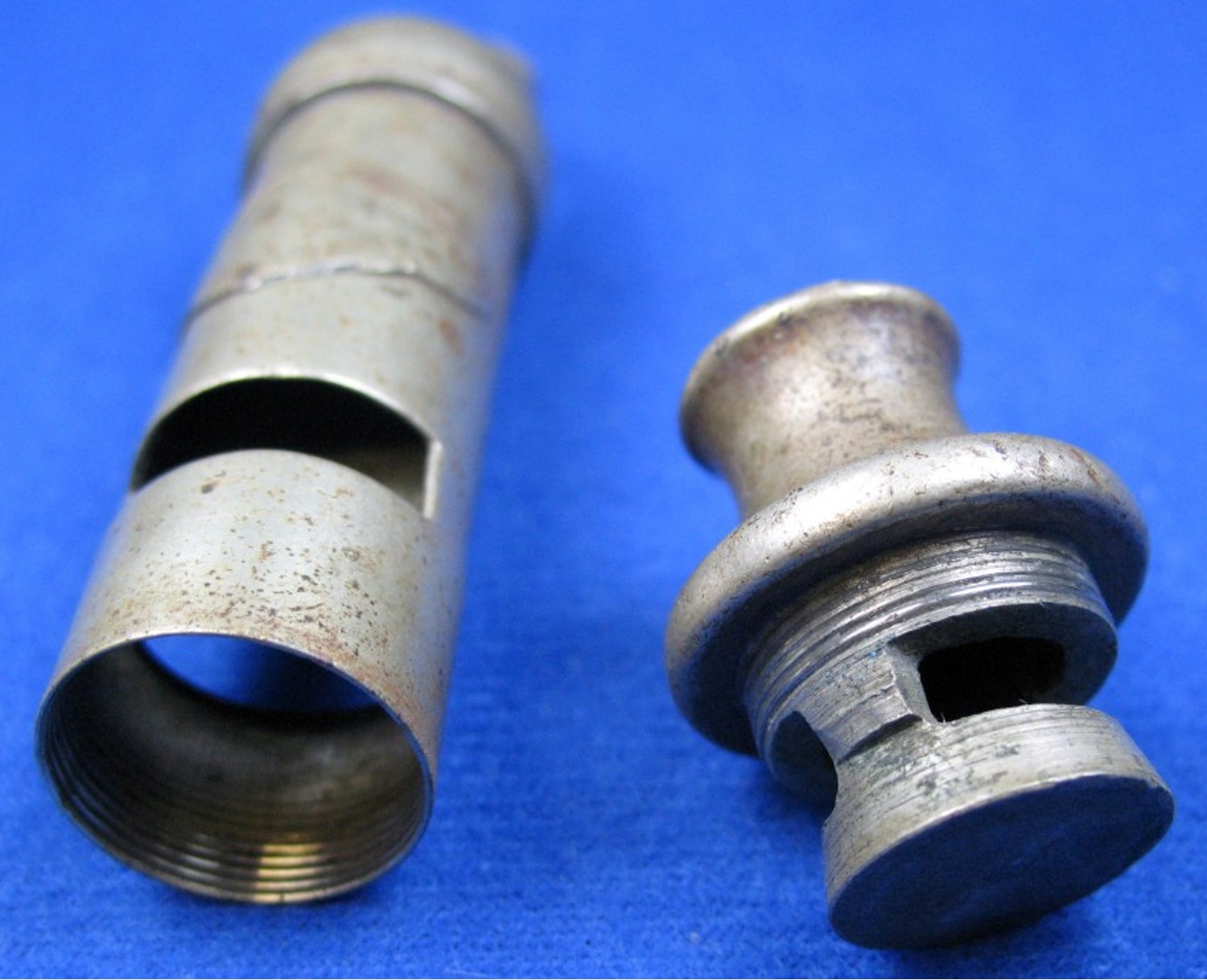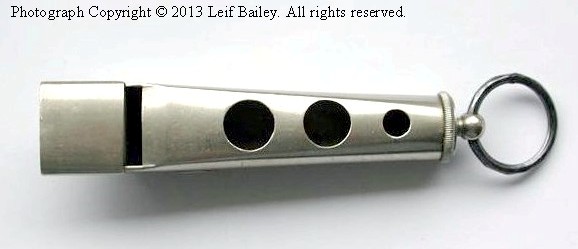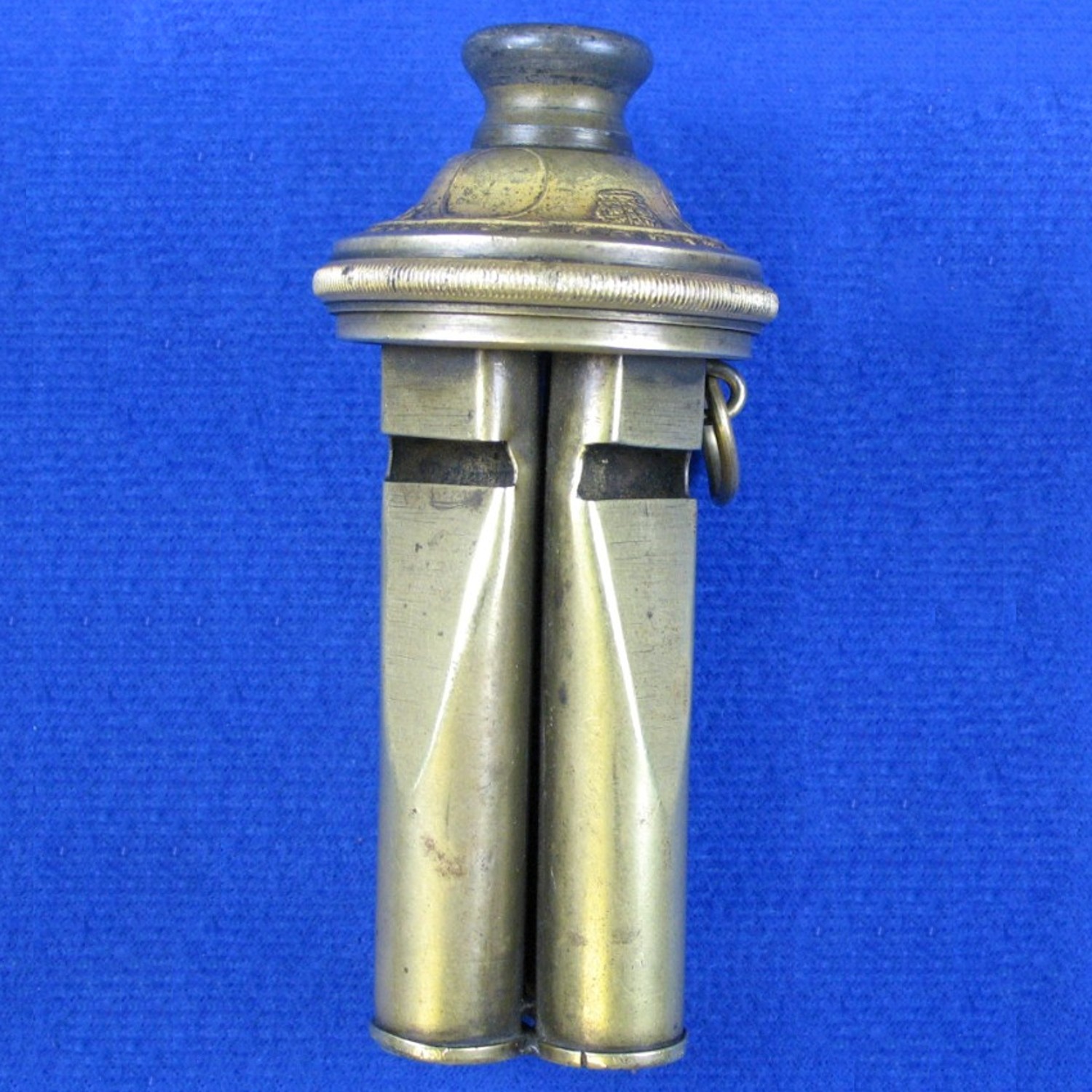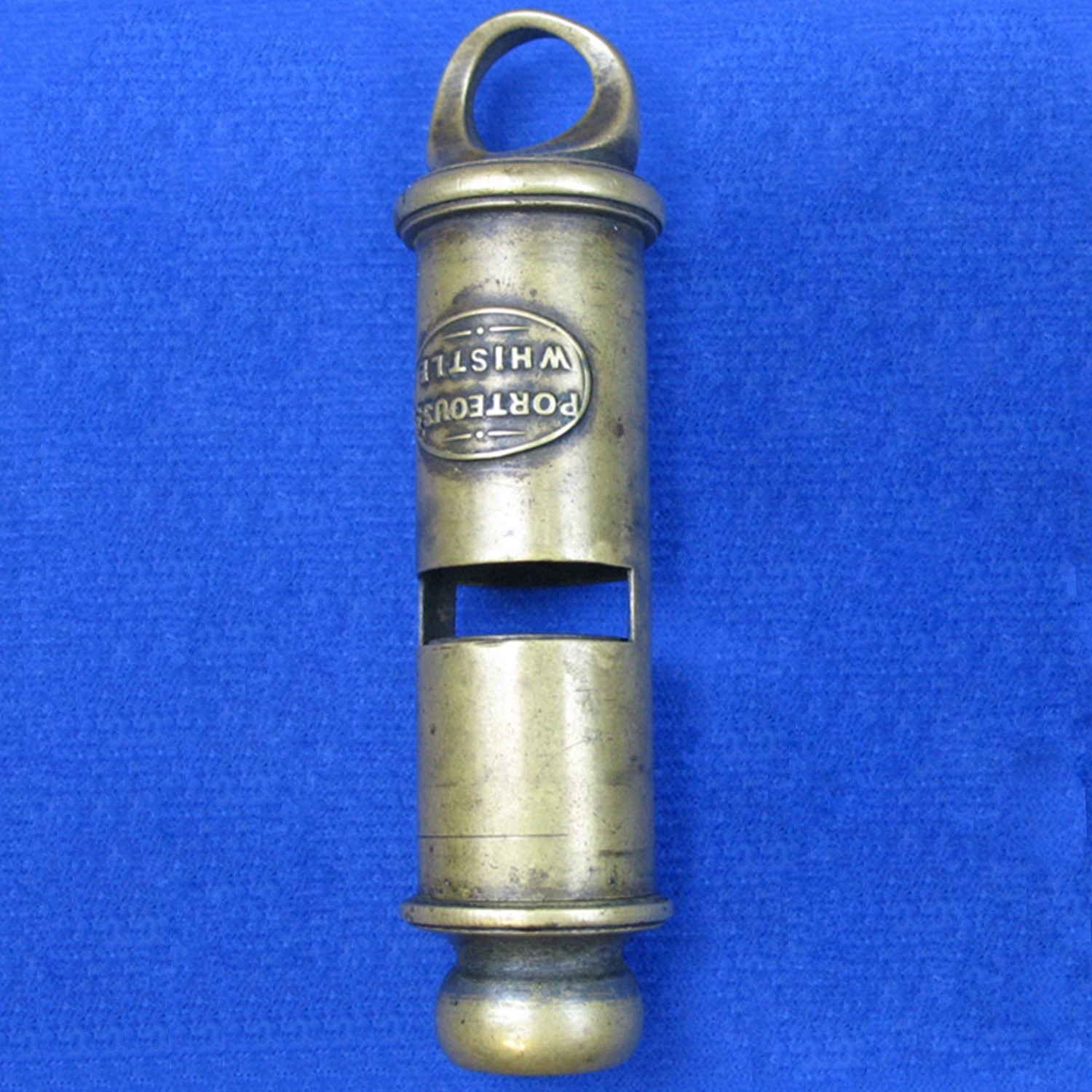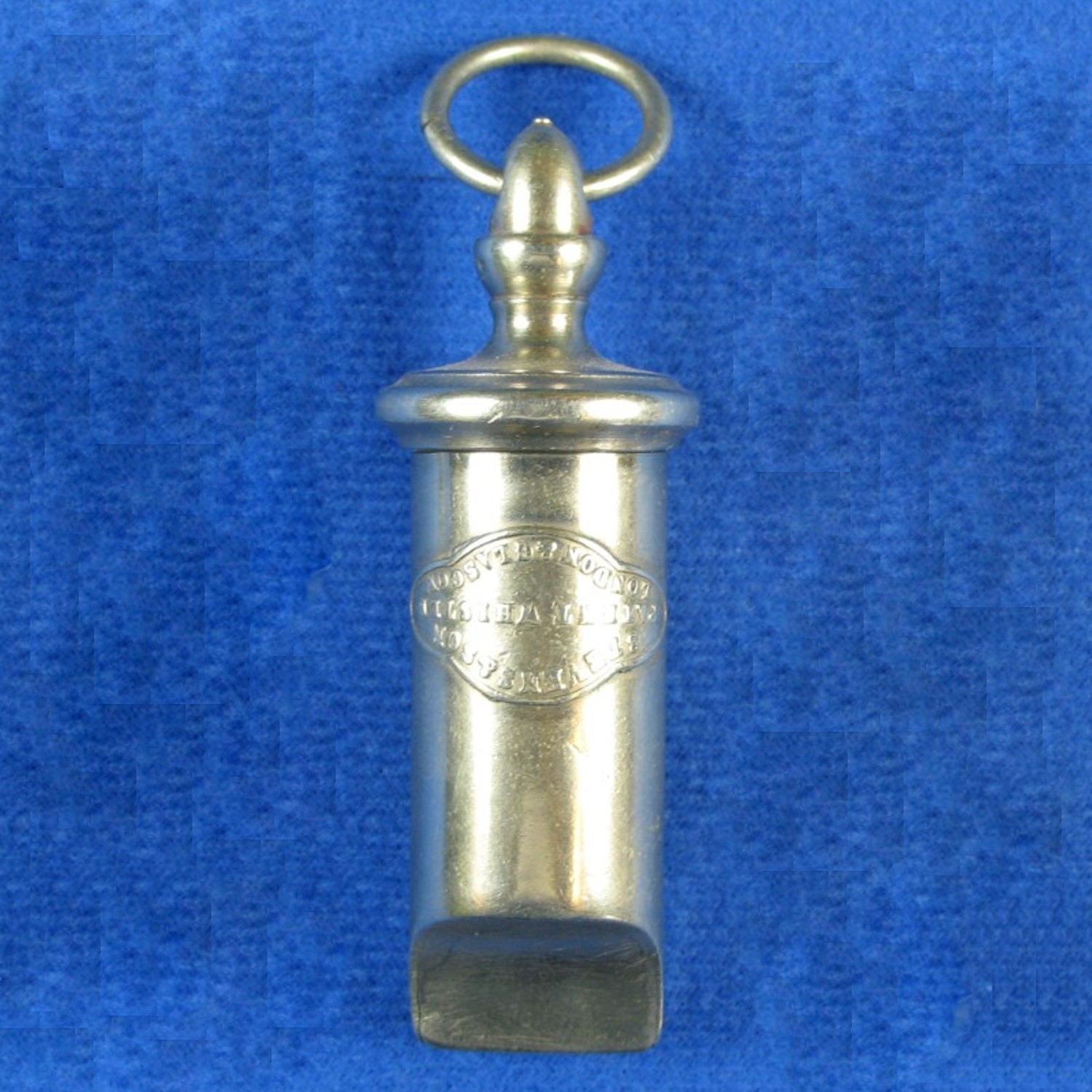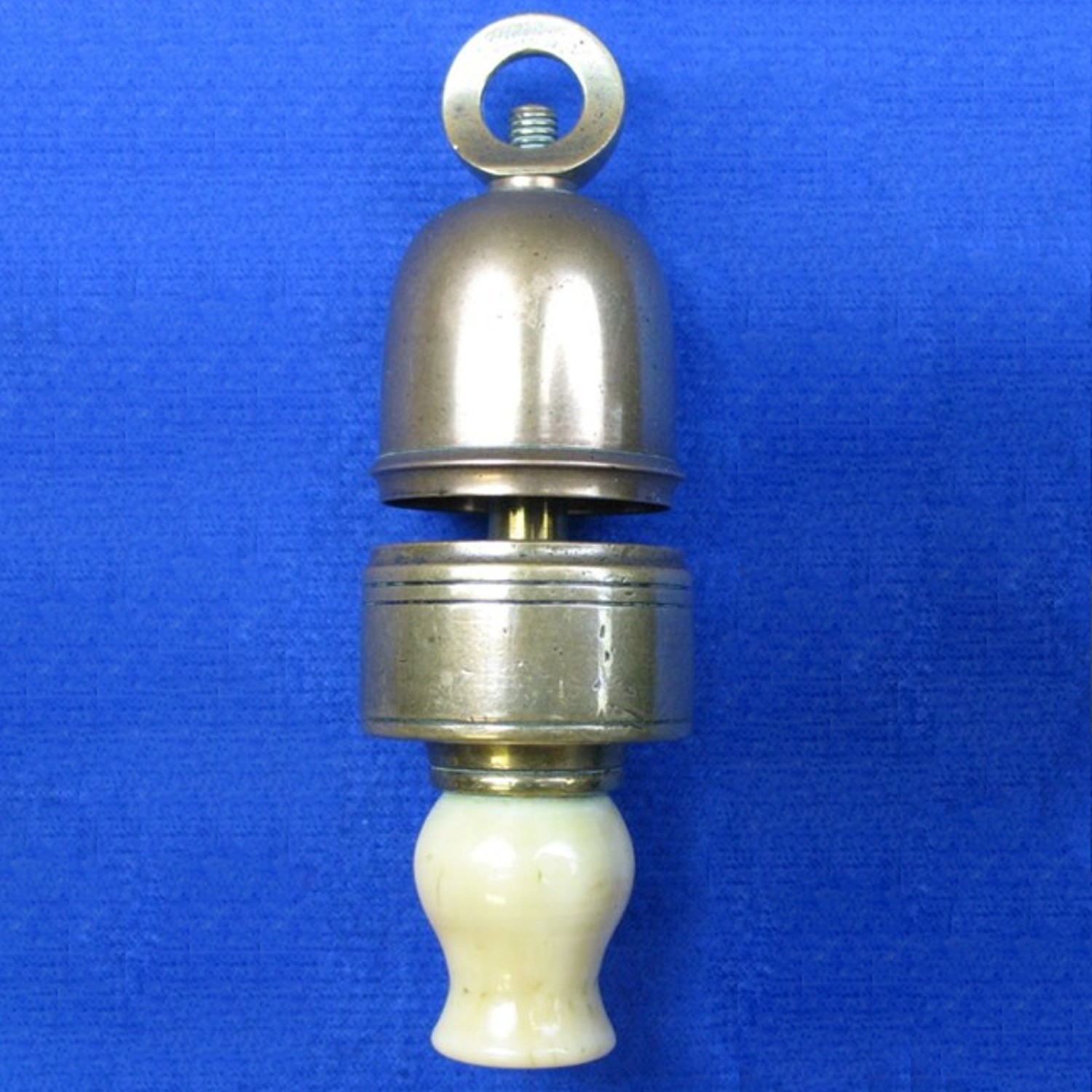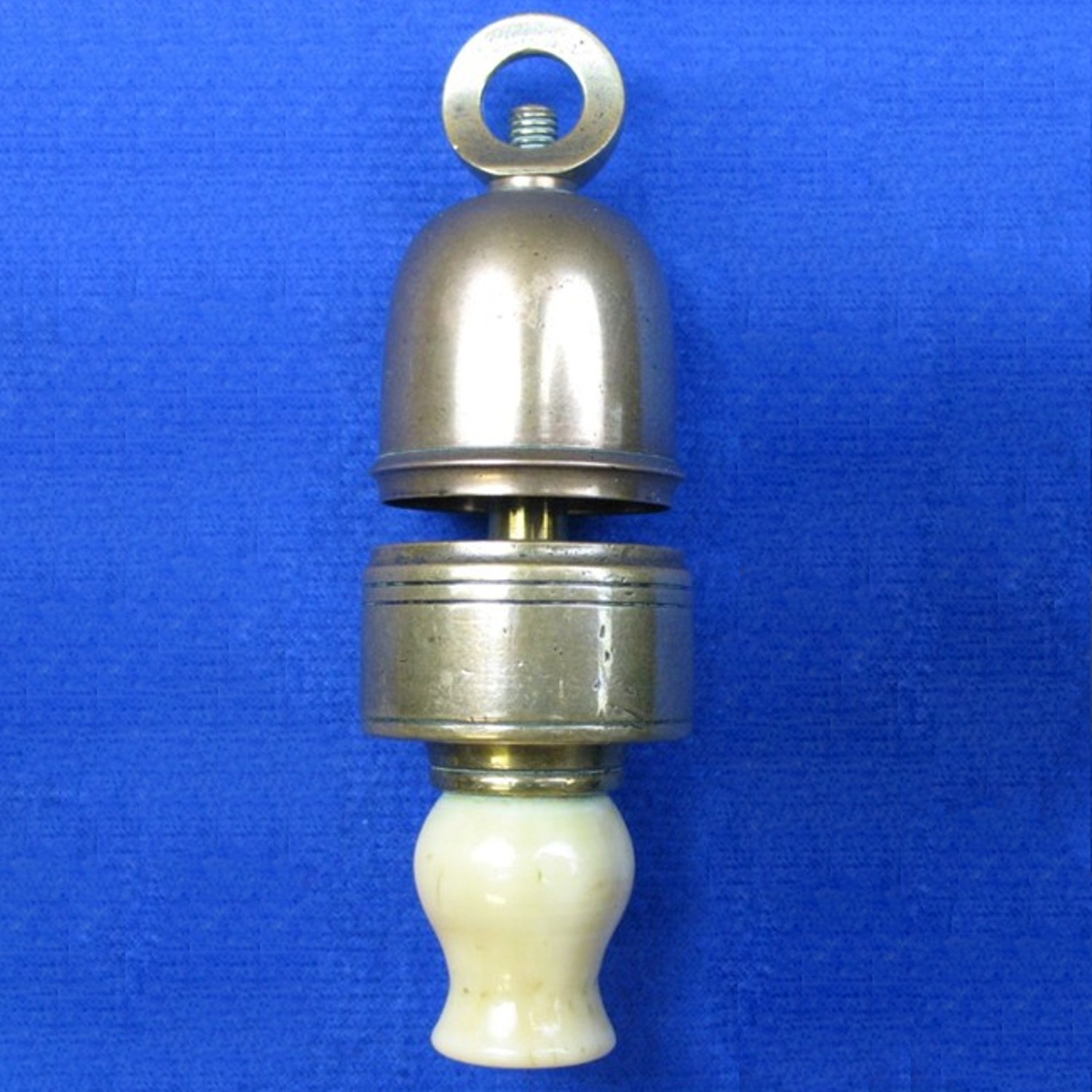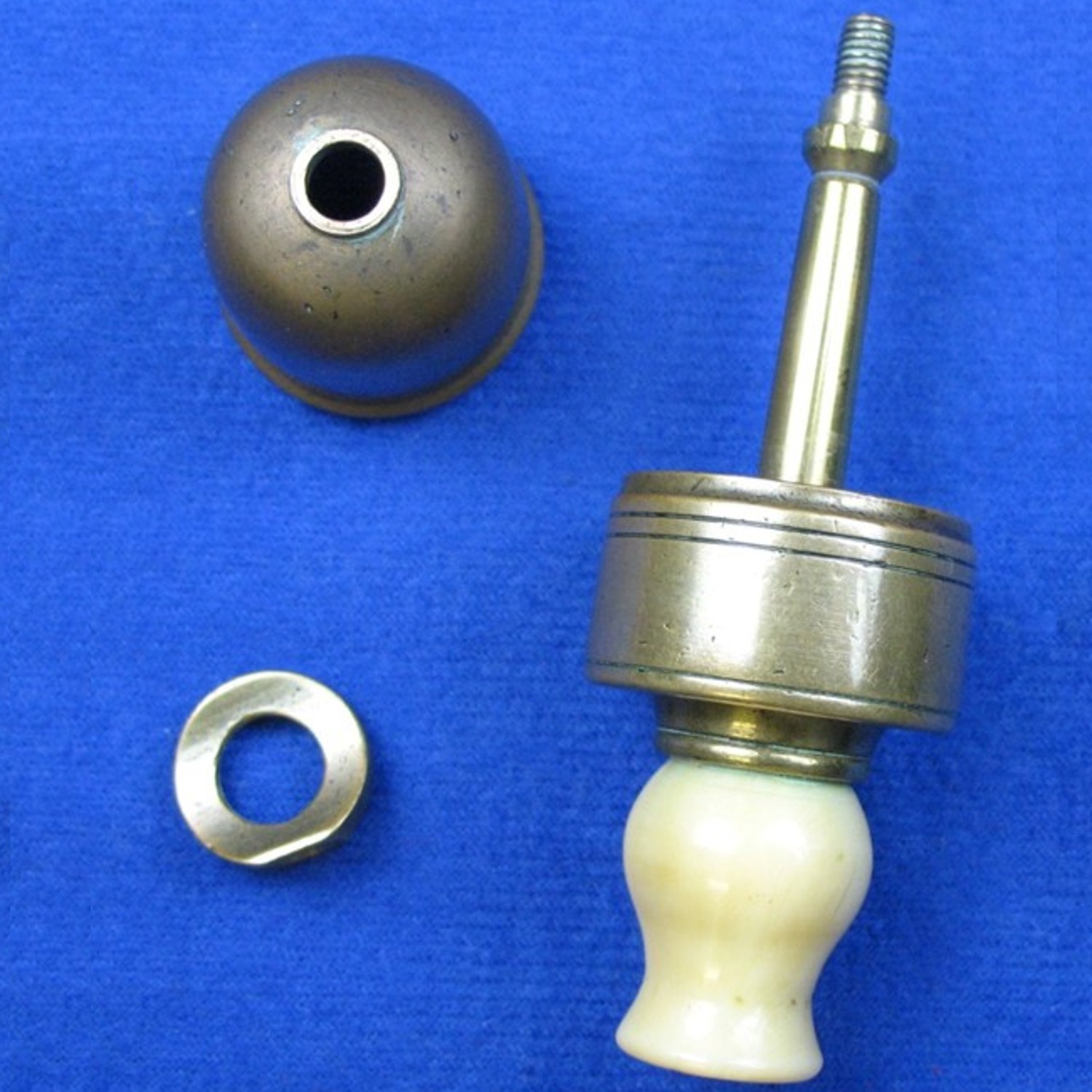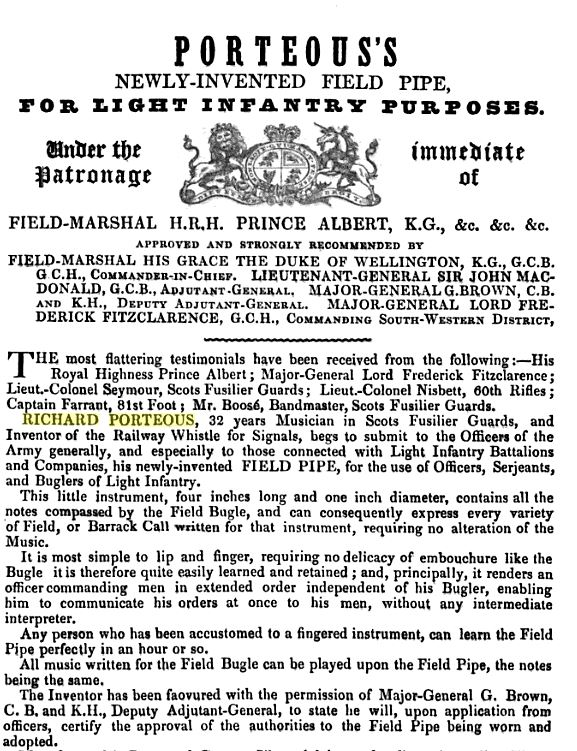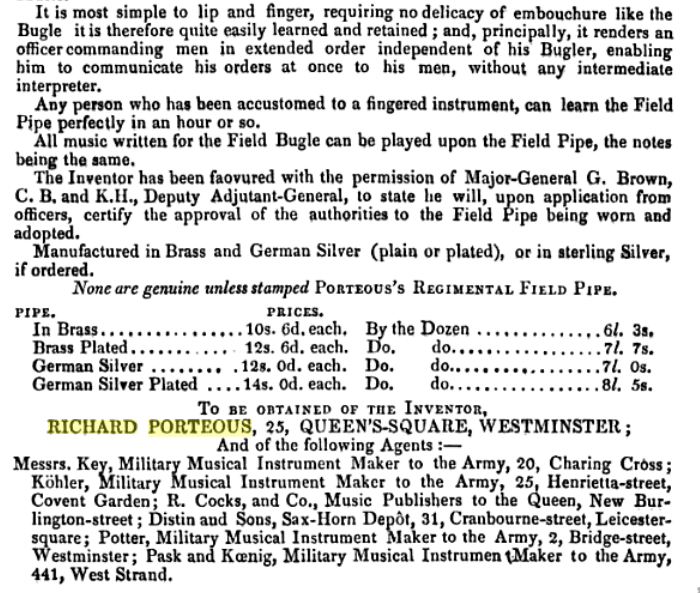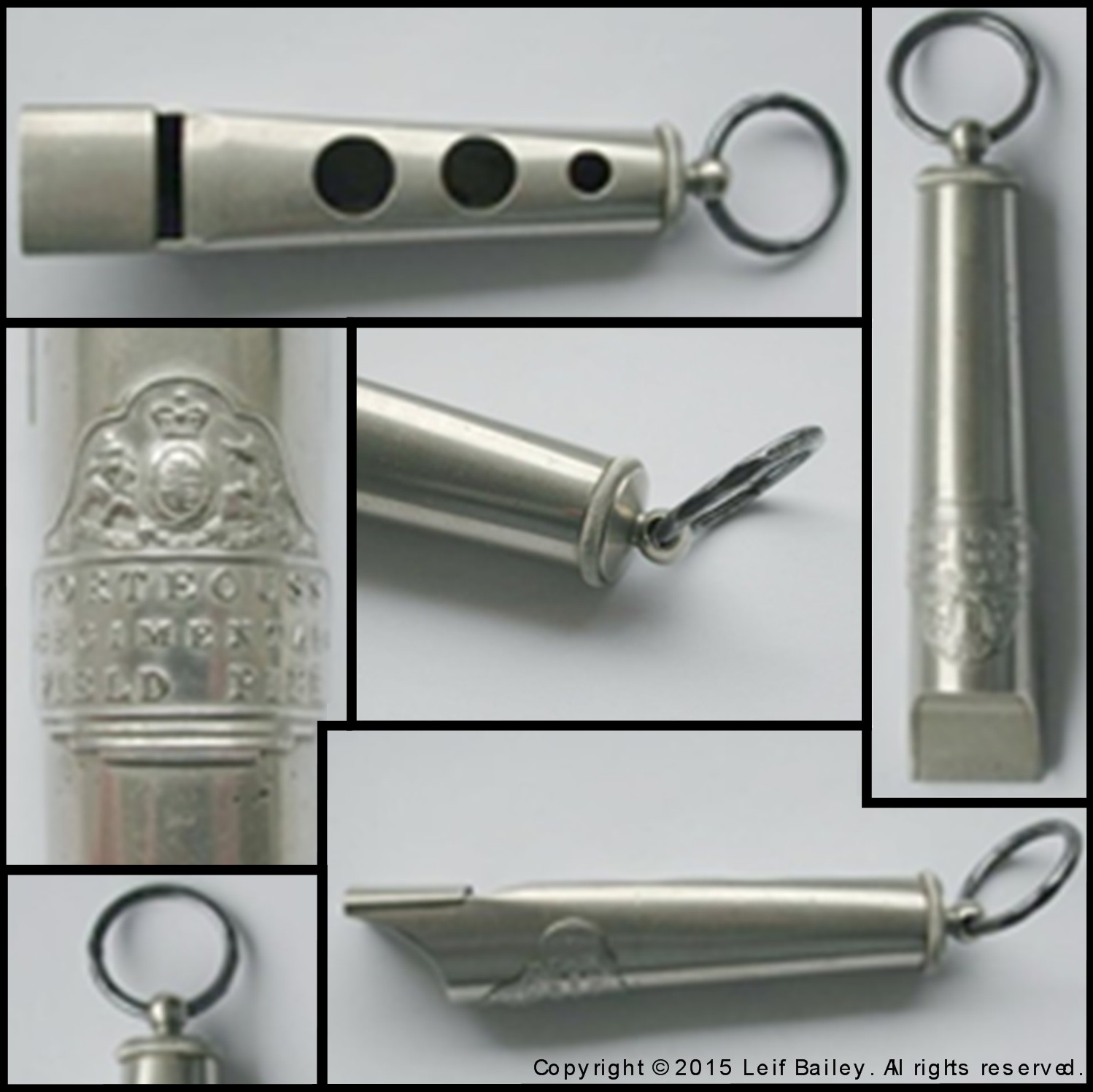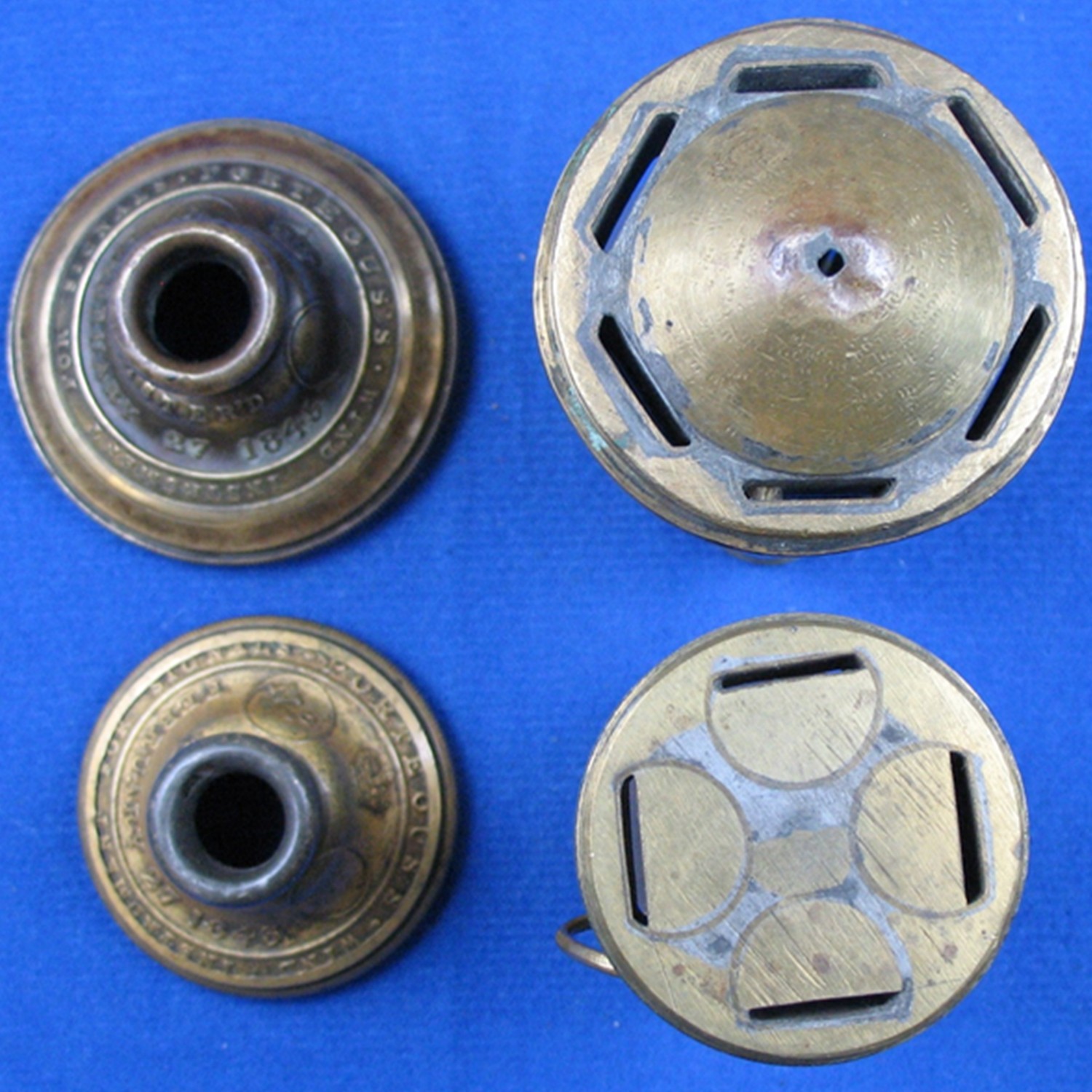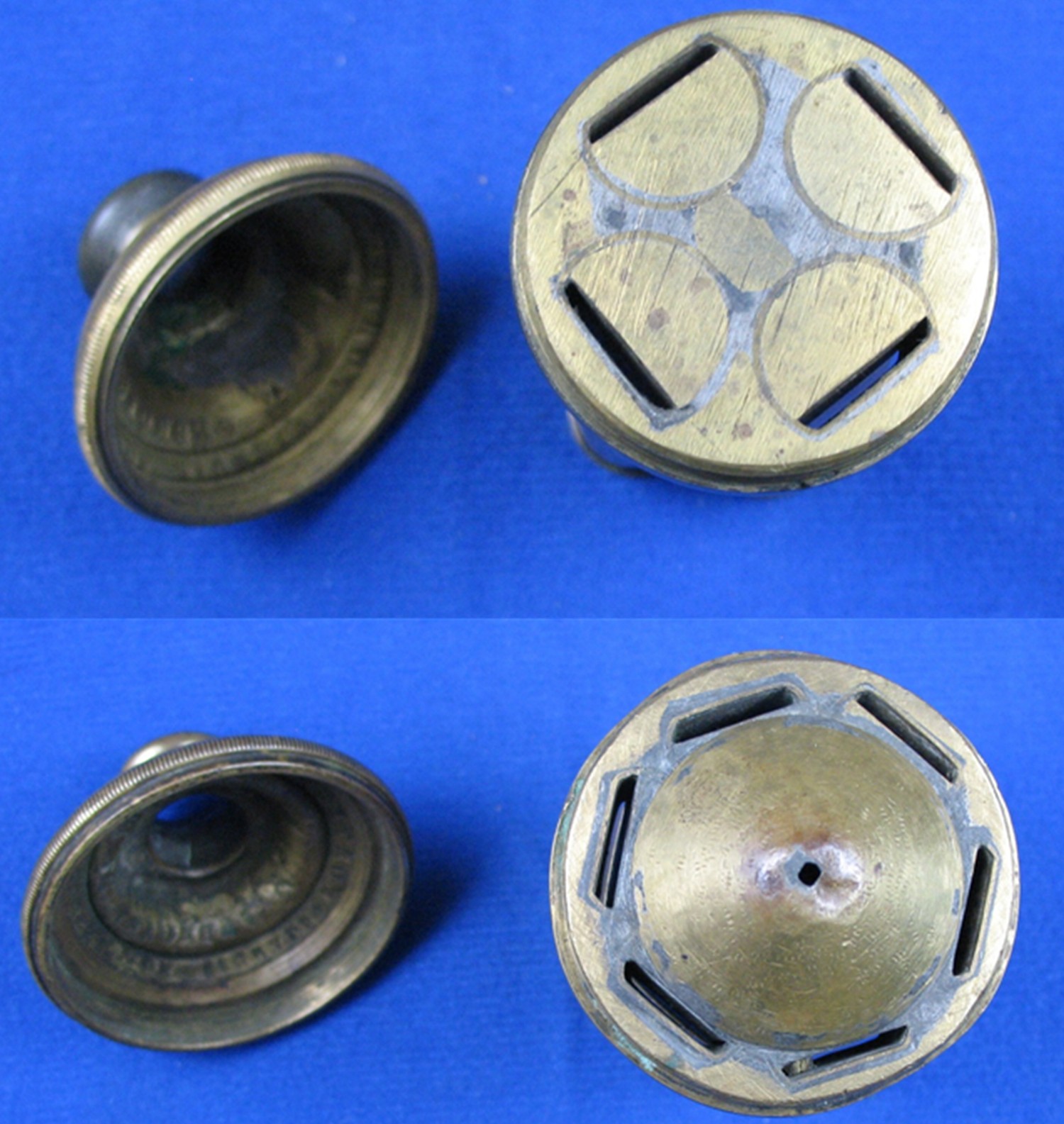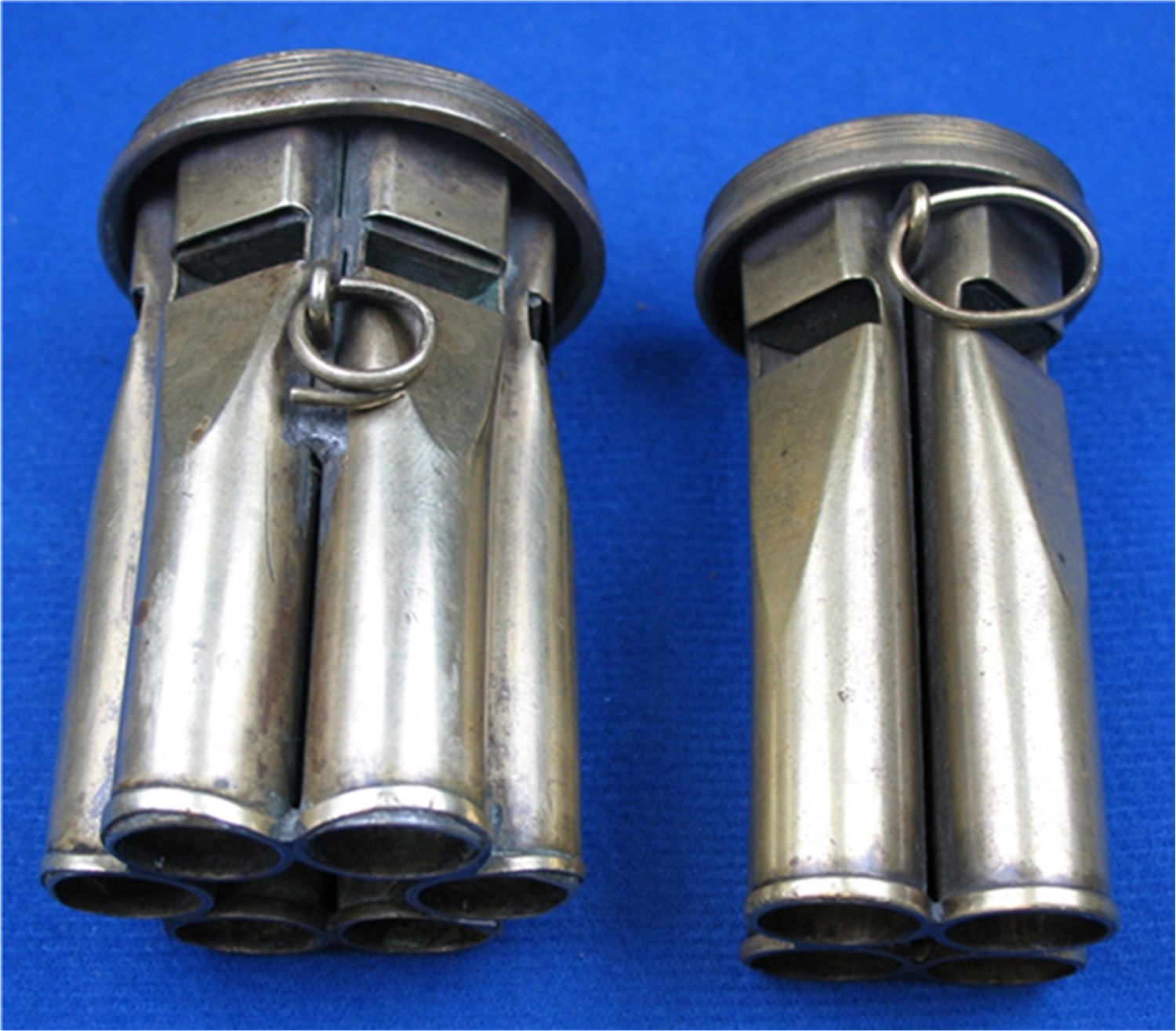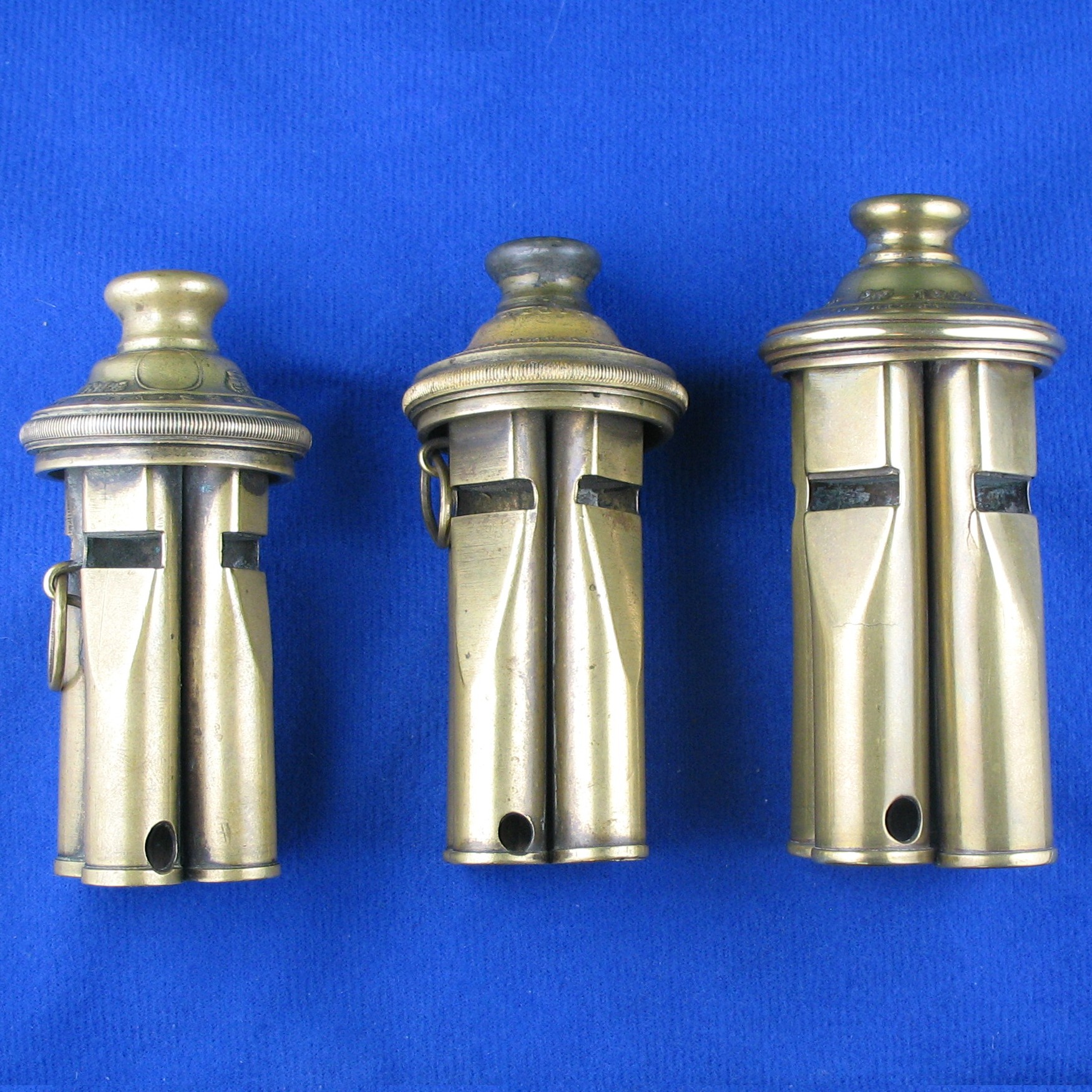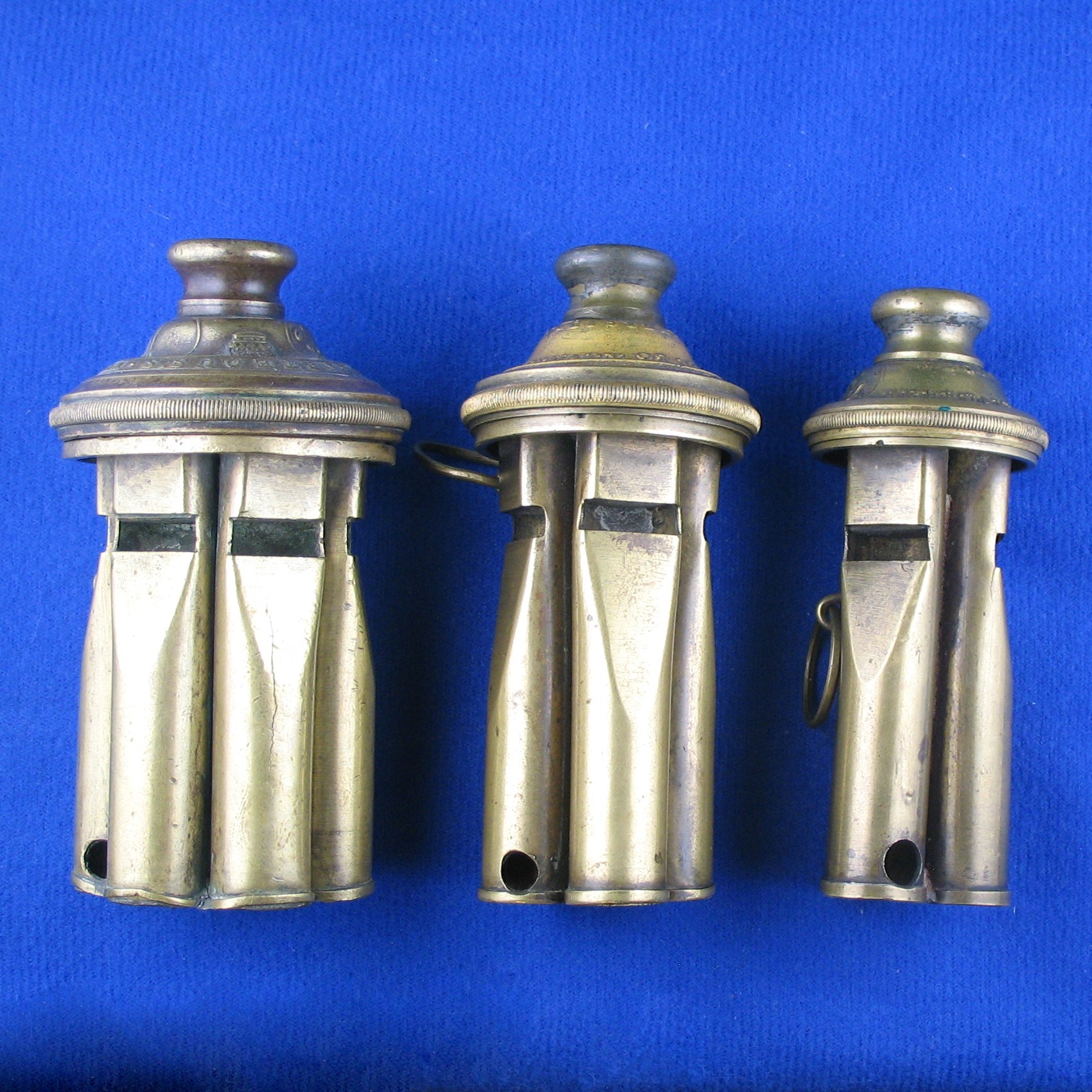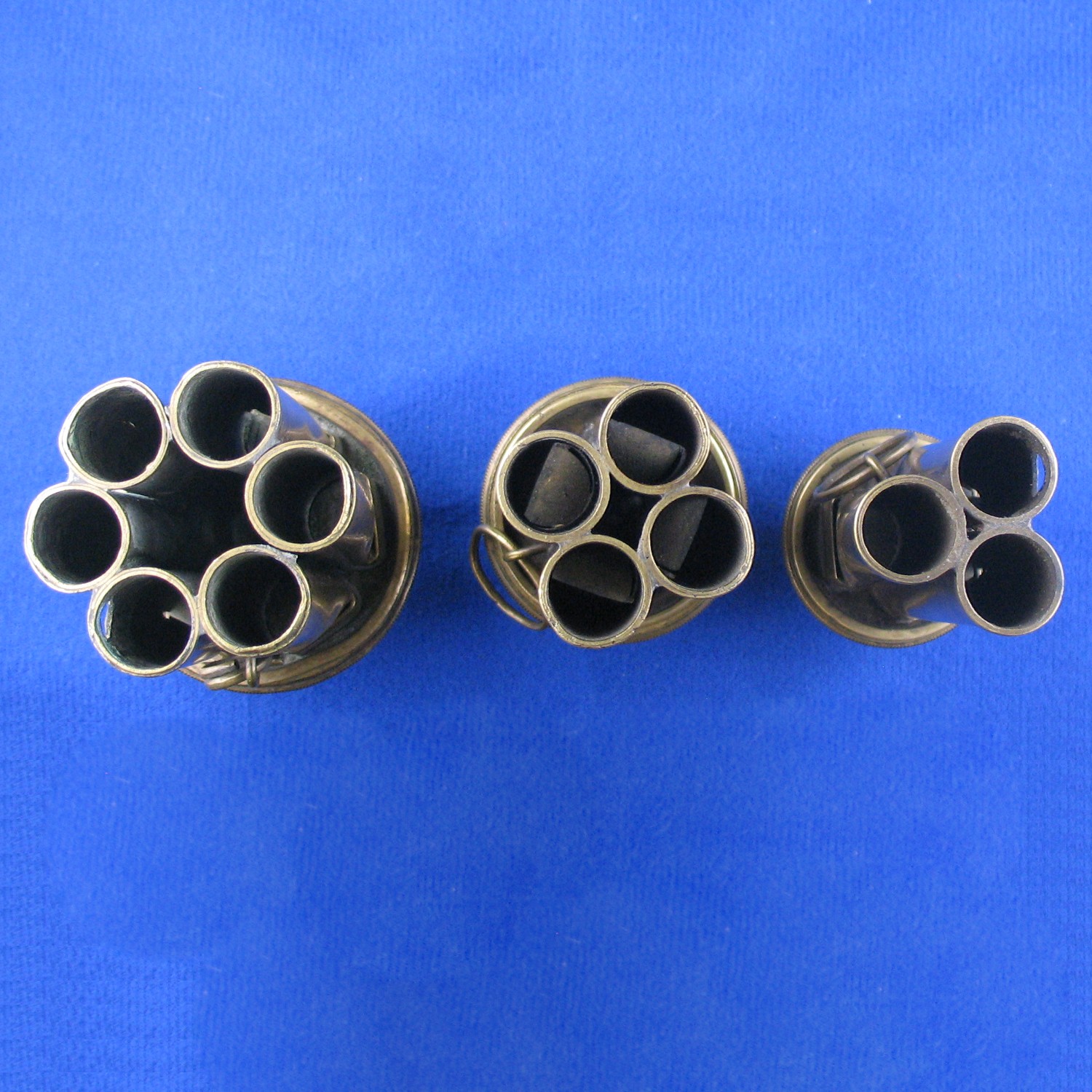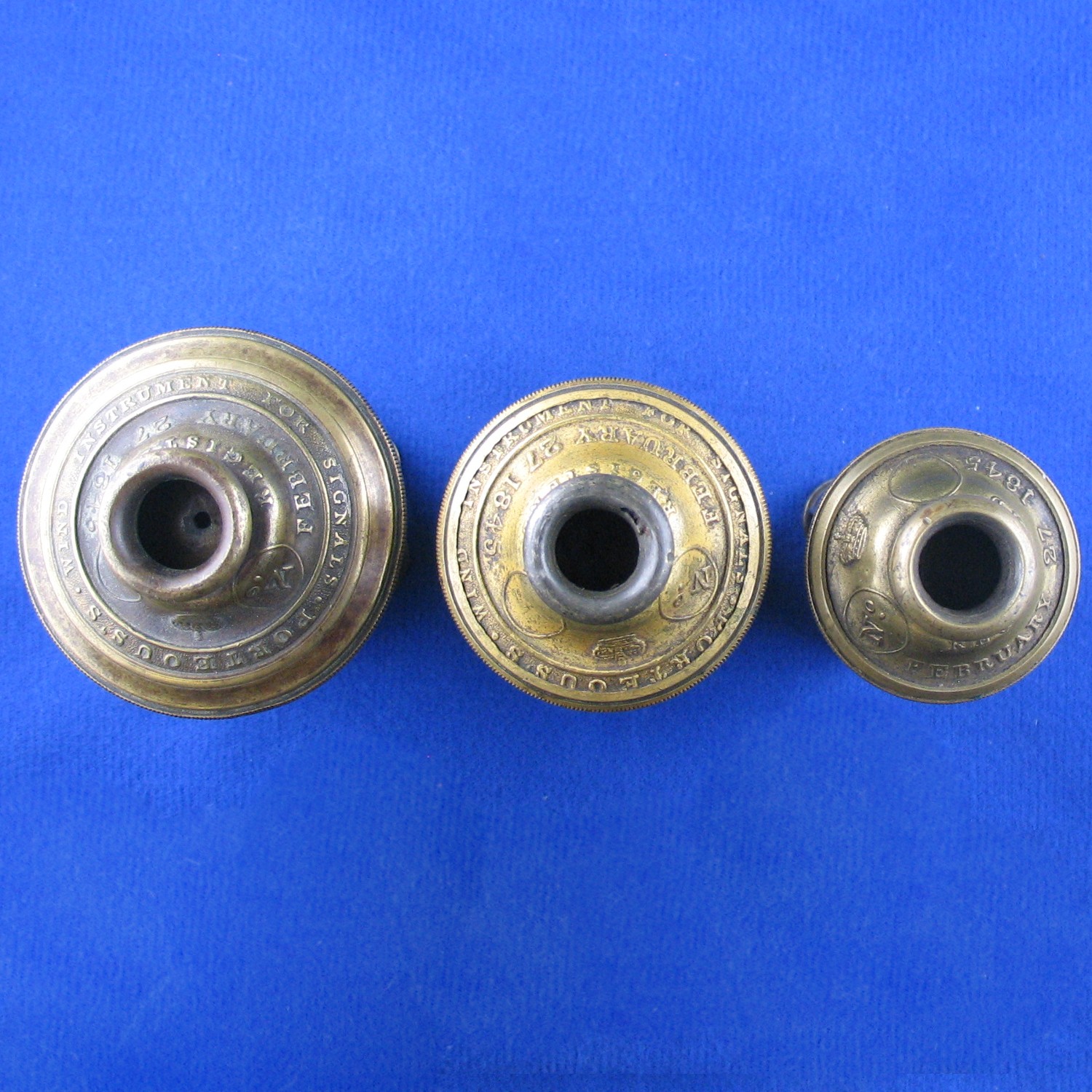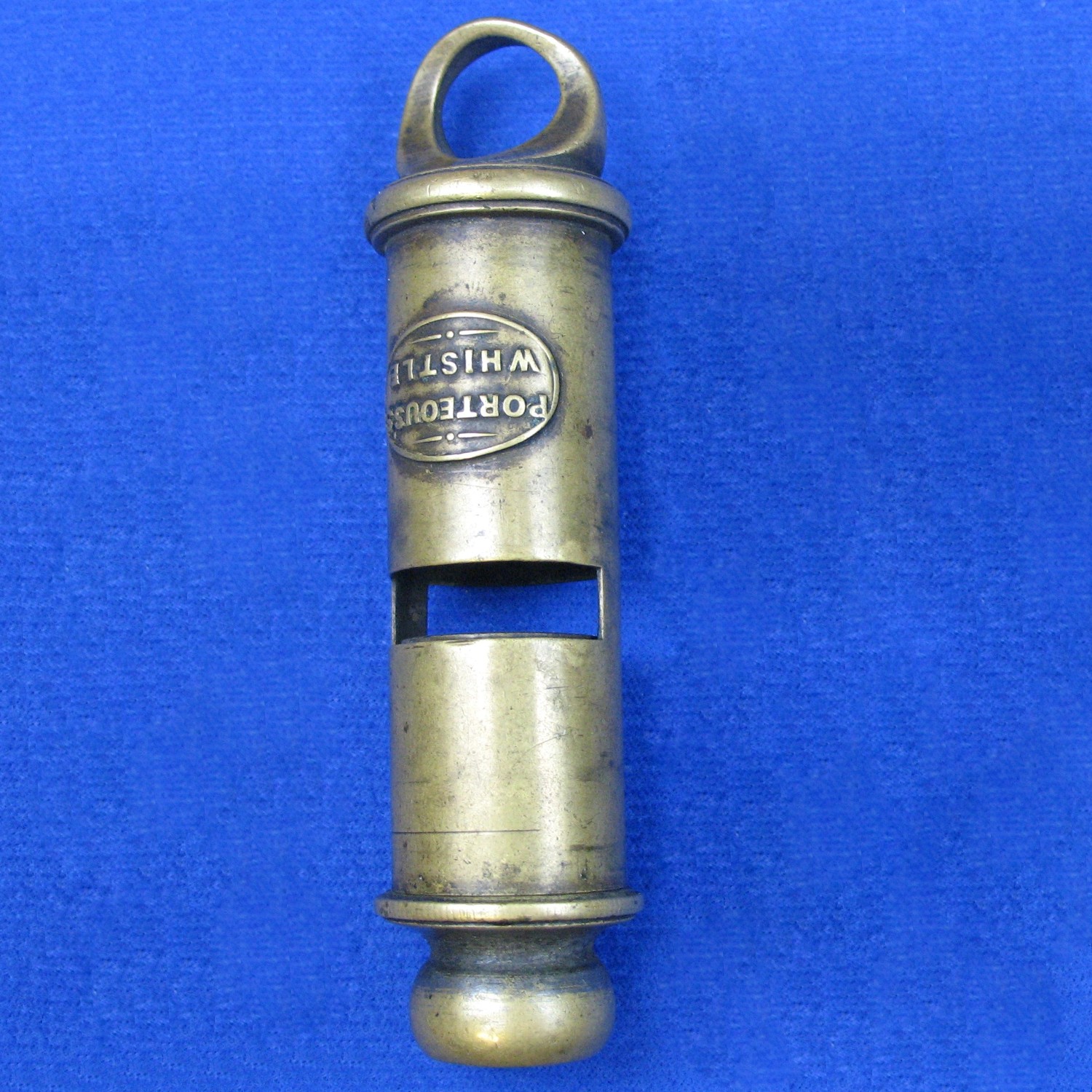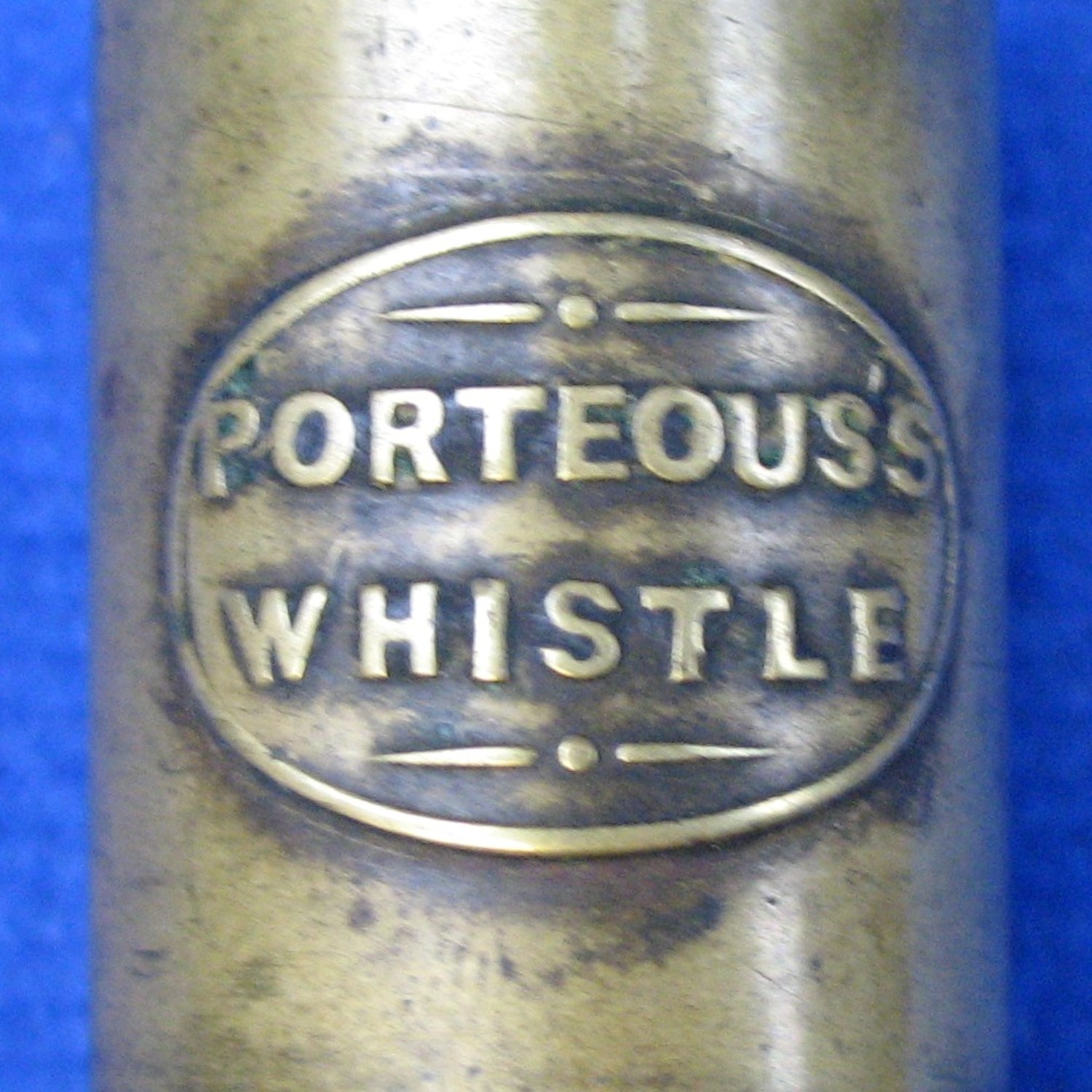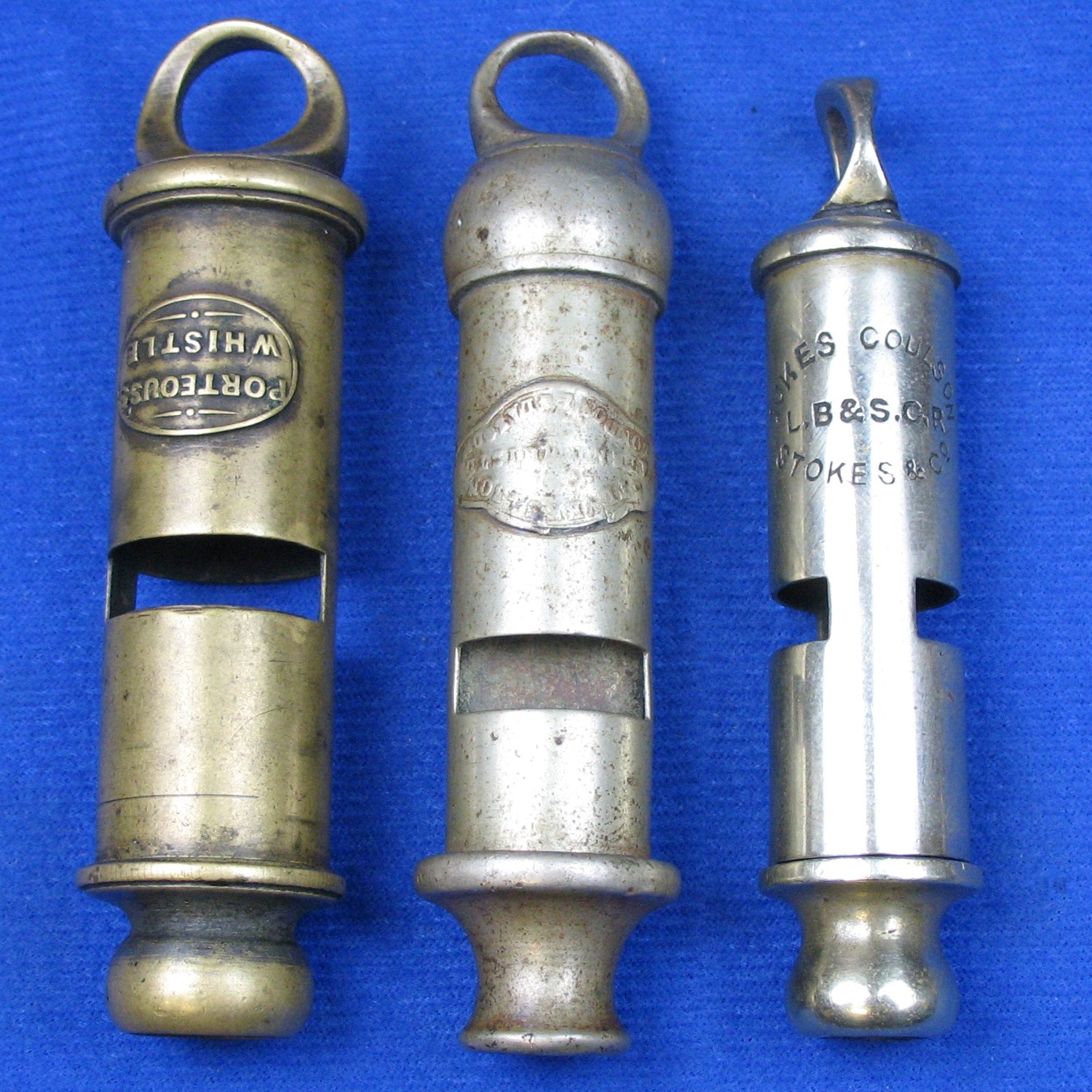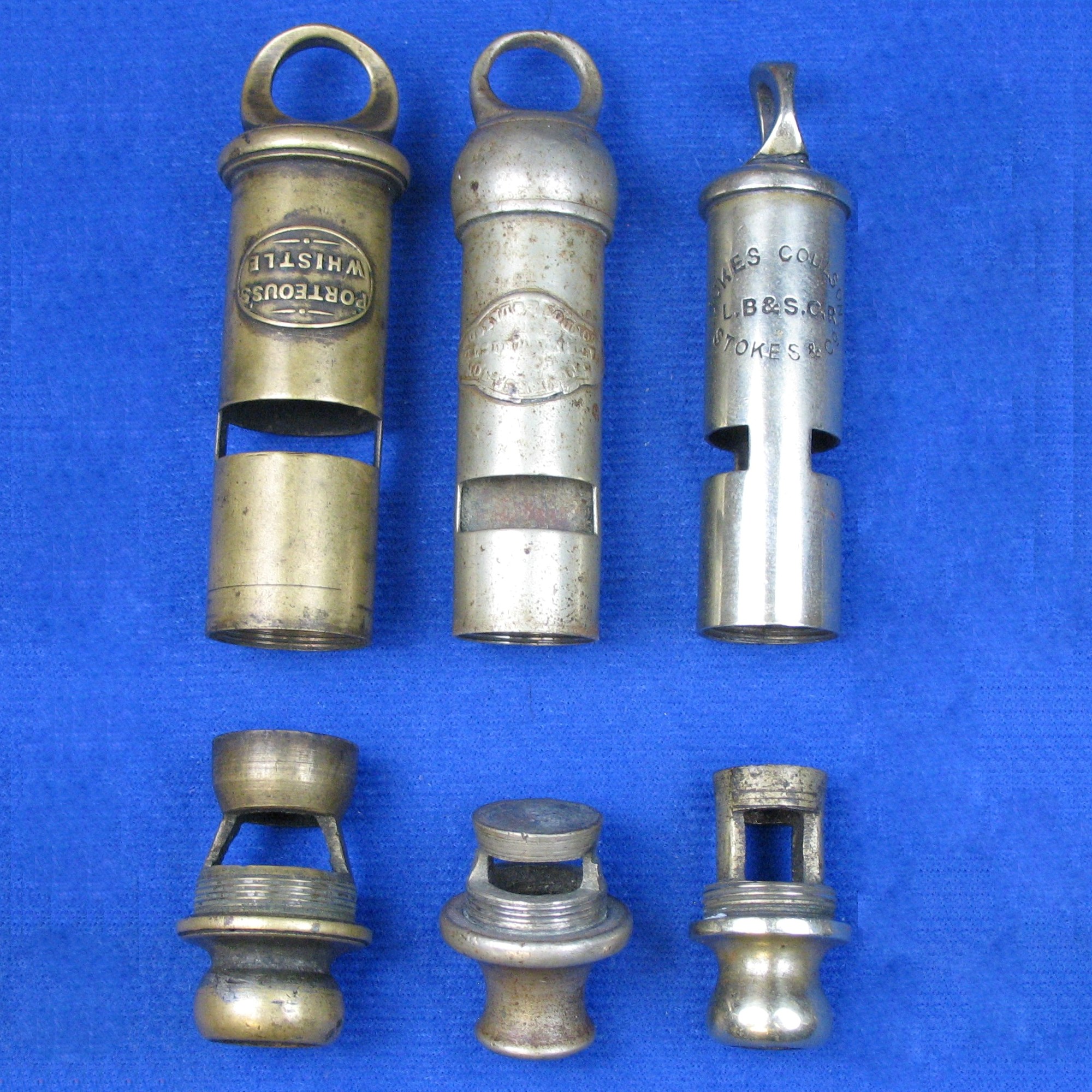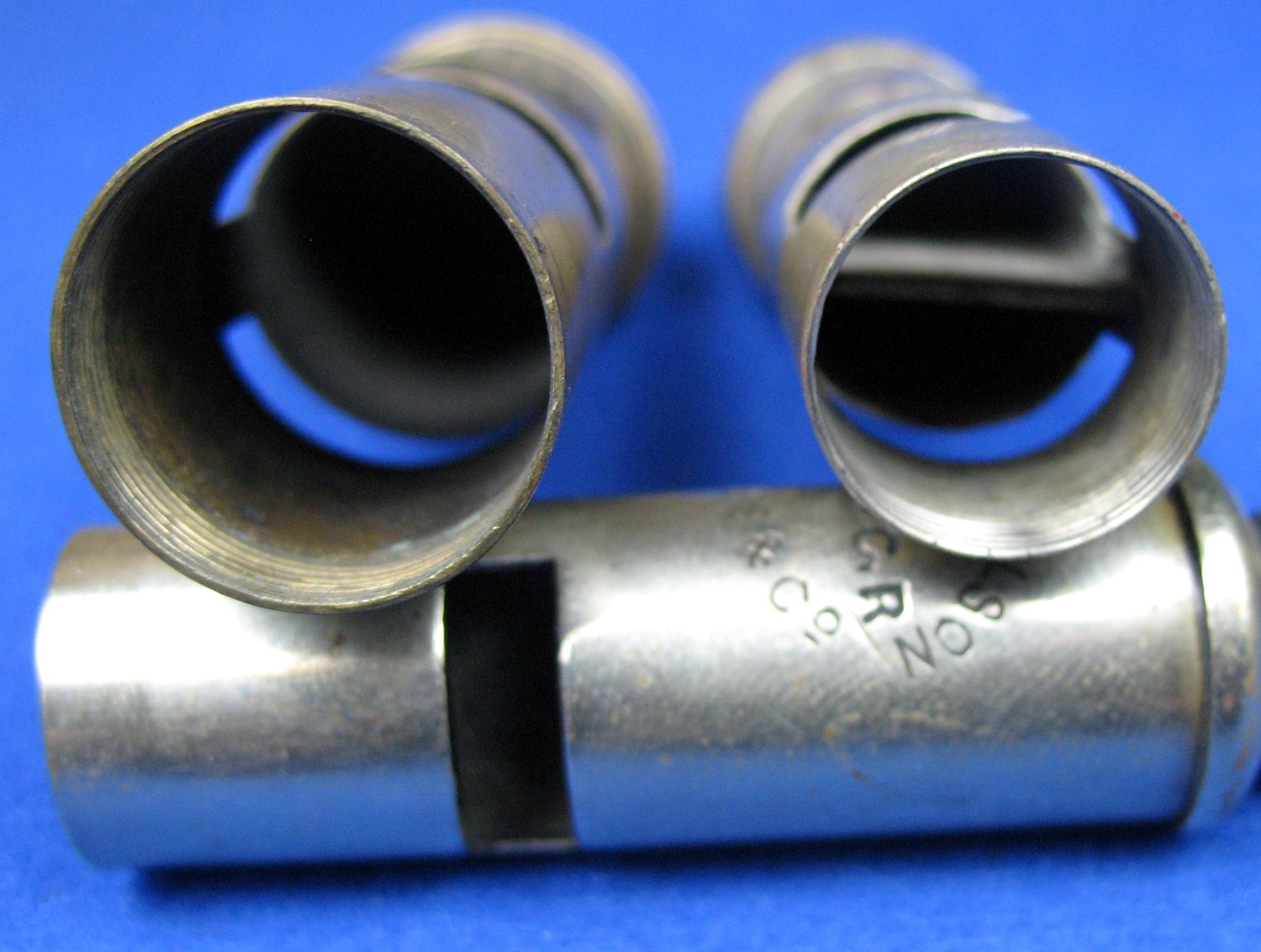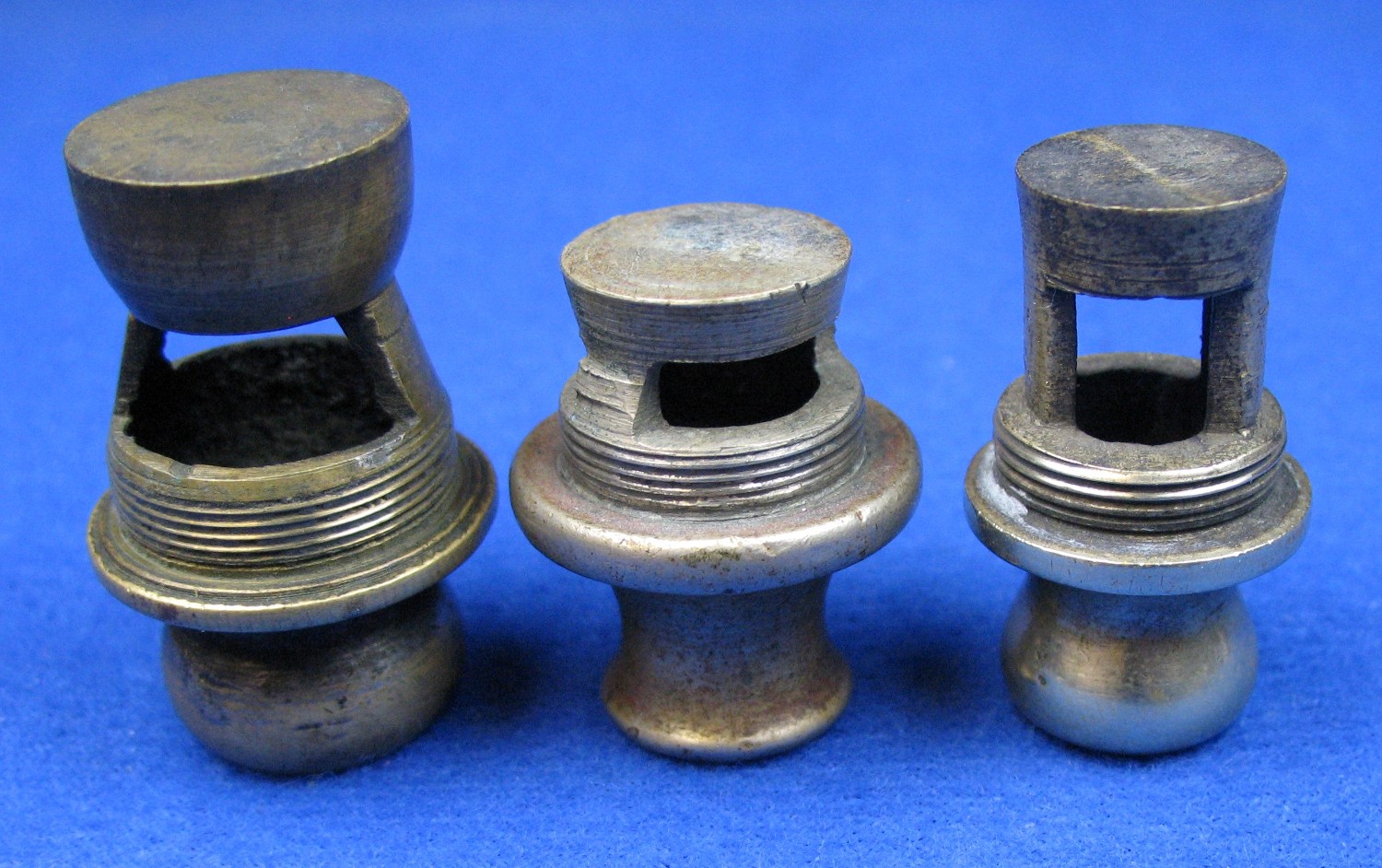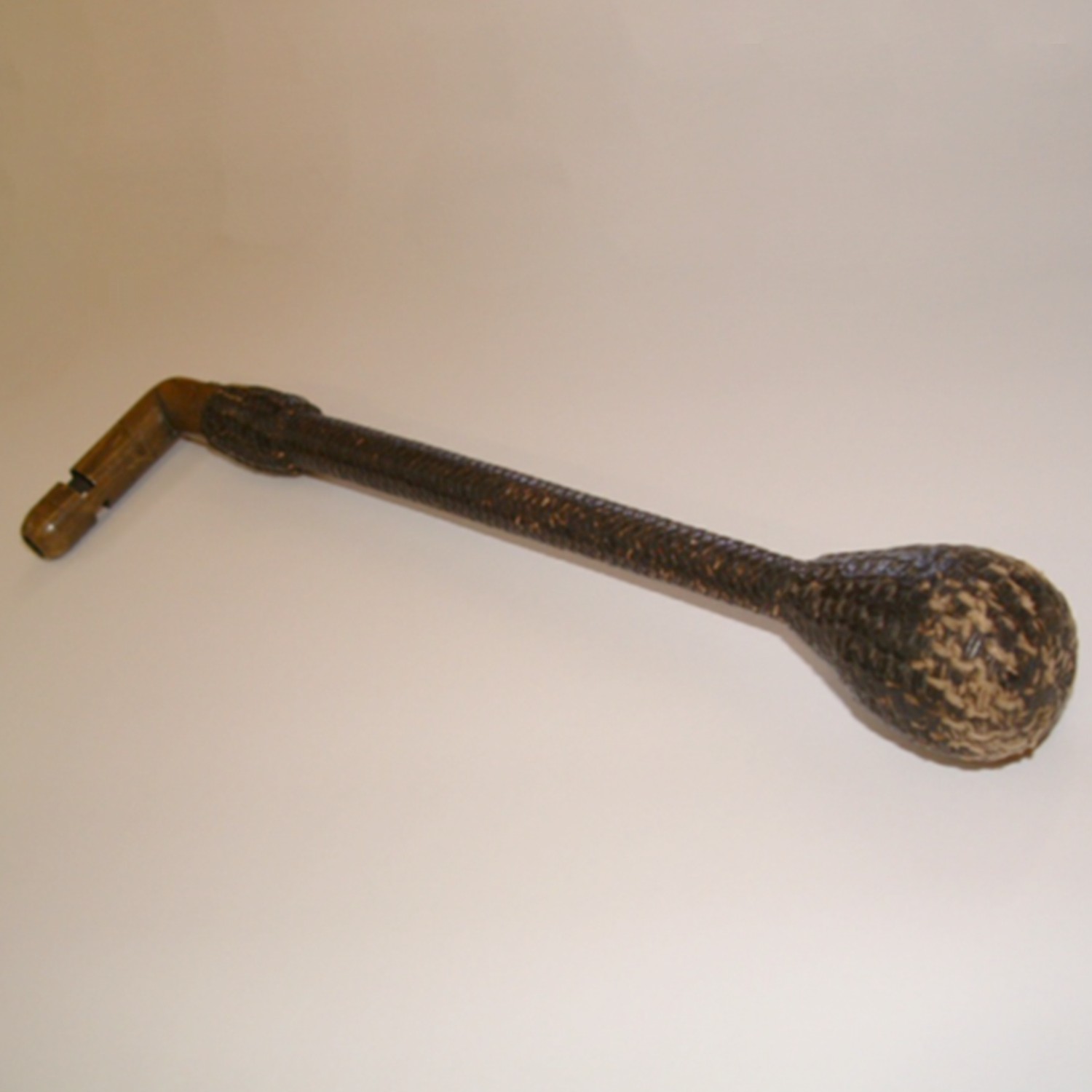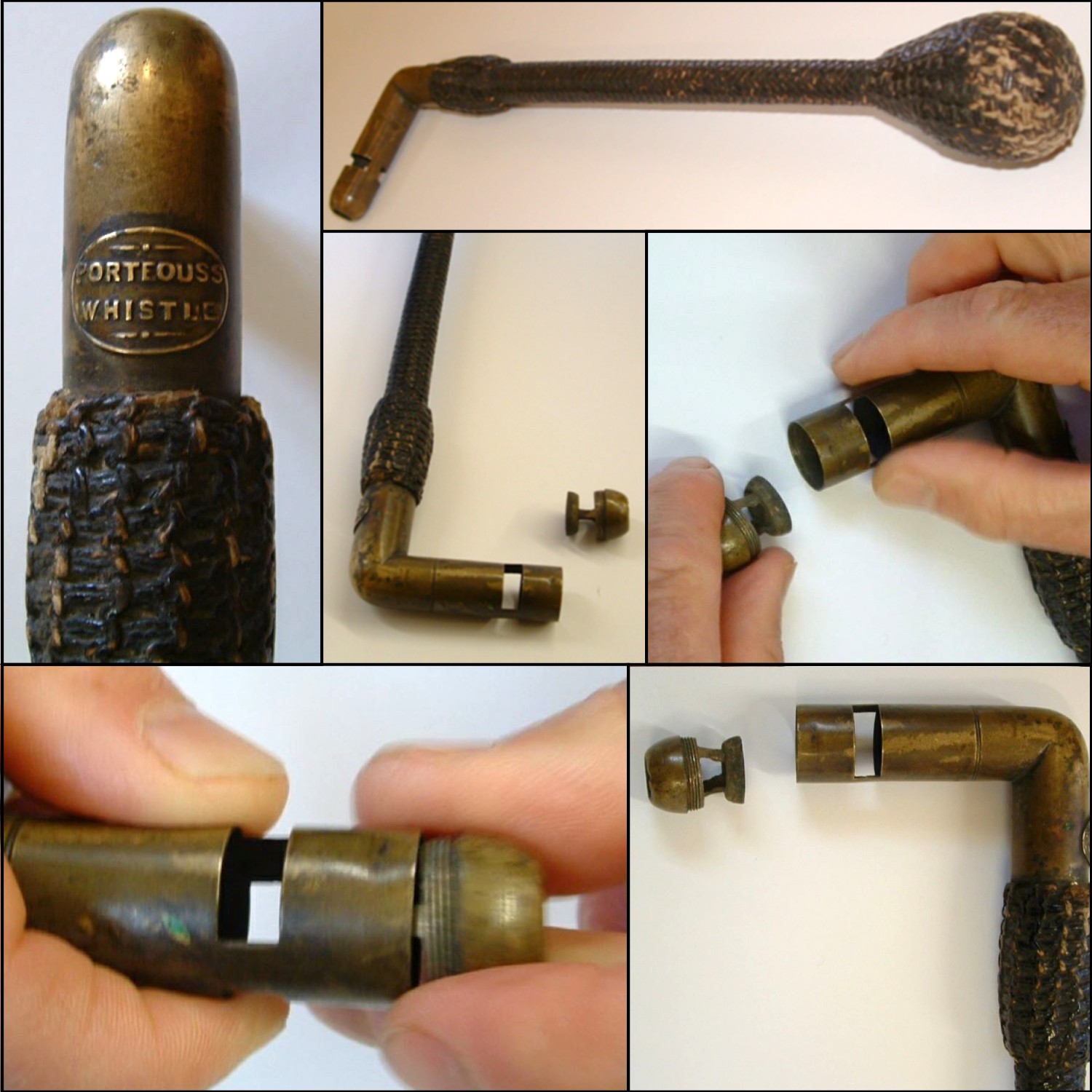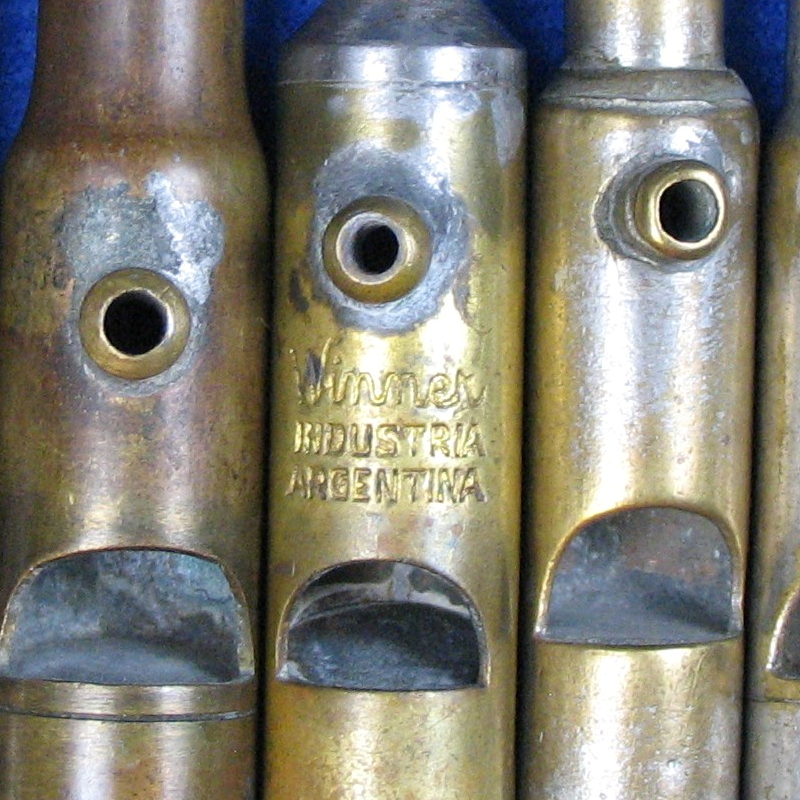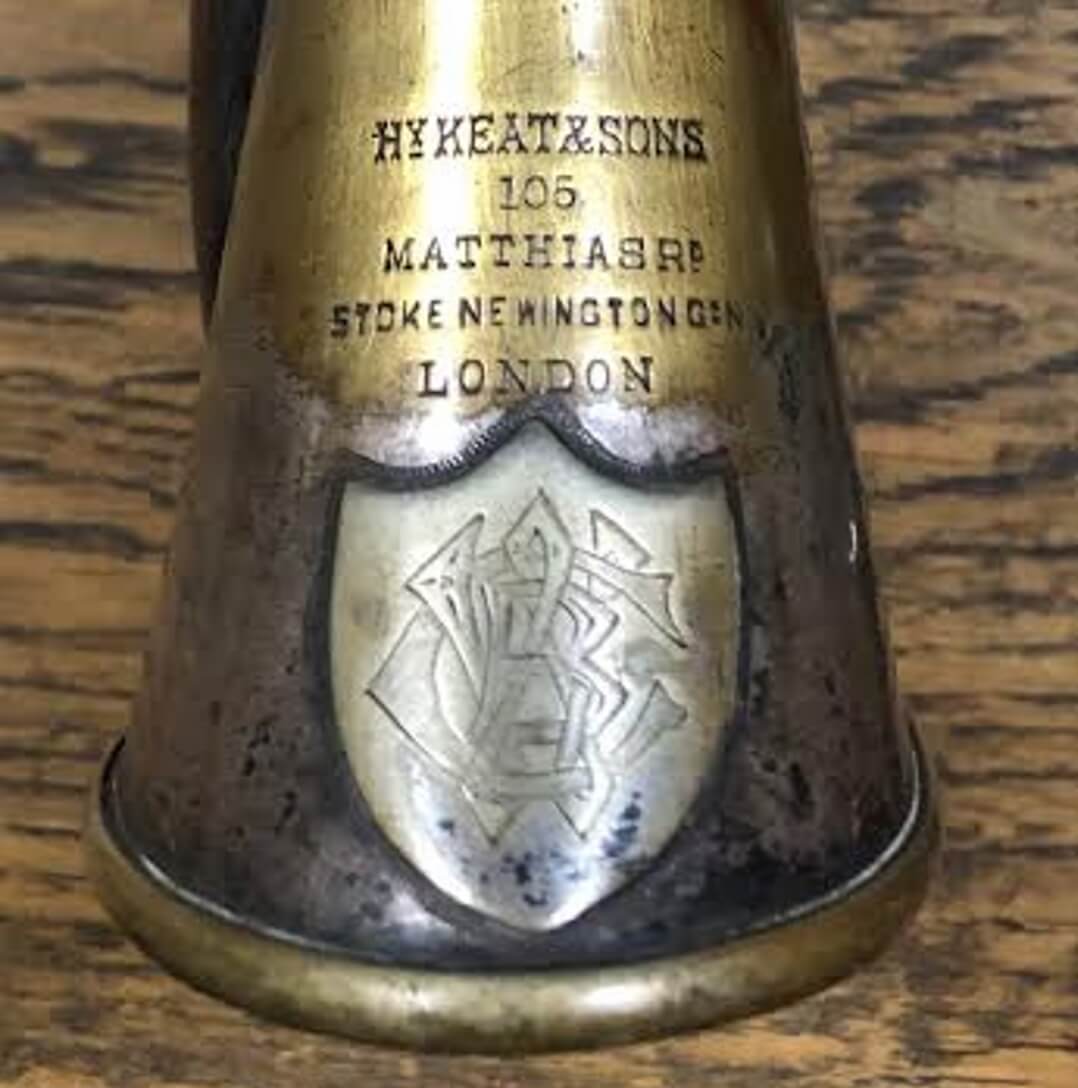Spotlight > Specific Manufacturer > United Kingdom > Porteous > 053
An excerpt taken from a letter written to TWG from Martyn Gilchrist:
I enjoyed and was impressed by the article [ Spotlight: Richard Porteous ], and it has realized a hope. That is, the books would open up the subject of whistles, and those after me would be encouraged to research further and add to the body of knowledge. I feel your article is a great contribution.
– Martyn Gilchrist, May 28, 2013
For many years in the present whistle world, there came to be a given name Porteous, known for ‘Porteous top‘ whistles. It is a rounded domed top to tube shaped police and general service whistles.
In time, they came to be used by four different manufacturers. Hudson was the last to utilize it and changed it to a two piece top. Prior it was one piece cast.
Who named it? Who designed it? Who was the first manufacturer? Gilchrist states (Collecting Police Whistles 1998 ) that “it is not known who ‘Porteous’ was”.
This ‘Porteous” design appeared first in the 1860s and was presumably manufactured by Stevens and son, brass founders, railway and gas engineers ( post 1870 the name changes to Stevens and Sons – Gilchrist 1998 ) and it is at this time we first see the rounded, almost ‘bulbous’ looking top that sat atop the ring end of the classic tube shaped police or general service whistle ( as seen below ).
These whistles were marketed towards railway and police forces, however they were also manufactured for cycling, ( i.e. stamped The Road Clearer ), asylum and for other general purposes for the public.
We can compare two types, first Porteous top below left (– circa 1865 with the classic bulbous top named after him, and the sloped top Metropolitan, 1883 (by Hudson ) for comparison. Both are cast. An important, a much more ‘flattish’ type top by Porteous was made preceding this design of the Porteous top — circa 1860 and is shown further below.
This has resulted into continued research into this name, design and of course into the whistles attached to his name. It has revealed that many whistles of the time are connected to one person. More importantly, designs that were credited to one company ( i.e. Stevens ) were designed by Richard Porteous.
Here is presented the fund of knowledge on Richard Porteous. At the same time new information and whistles continue to come to our attention and rather than continue to add addendums, we are re-writing this article to update it.
Since our first posting we have seen several model sizes in the Wind Instrument of 1845. Obtaining the 1860 GSW has allowed closer examination for presentation. Presently a remarkable and previously unknown ‘black jack’ in mint condition came to light and is presented here thanks to Gareth Edwards a fellow collector ( with much gratitude !! )
In the future we will continue to create rewrites/addendums as necessary. For example a slider is buried in records that Richard Porteous designed and would be a valuable addition to post.
Who was this person and how did his name get attached to this feature?? In fact the question begs to be asked – how did the name Porteous get attached to whistles and especially Stevens and son whistles?
A letter from Martyn Gilchrist, the author of three books on whistles from the UK wrote us answering this. ‘The name ‘Porteous top’ was coined by himself in Collecting Police Whistles’.
So one might ask why ?? “ The purpose was to make it easier for people to describe whistles with this top instead of resorting to a variety of words such as globular, spherical, etc.”
This ‘bulbous’, original design was first seen on whistles made by and stamped Stevens and Son ( pre 1870 ) and thereafter Stevens and Sons ( plural ). They were stamped on what looked like an over-label on the side of each whistle. Eventually these ‘Porteous’ tops would also be seen on whistles made by Dowler, Hudson and DeCourcy. No other manufacturers would employ this design atop these tube shaped whistles.
In researching this man we find Richard Porteous was born August 5, 1802 in Woolwich, Kent of the UK. He was the son of William and Mary. He died Jan. 3, 1881 Camberwell SRY UK. ( specific thanks to the Porteous family records – Porteousassociates. ) He was a musician and eventually band master later in life, starting out in the Scot’s Guard Band at the age of 11 where he stayed for 32 years. — He was not an engineer or even railway employed as sometimes assumed.
At the age of 32, approximately 1834, he placed an advertisement for his ‘newly invented’ Regimental Field Pipe for light infantry purposes. This three-hole; four inch long pipe came in brass, plated brass and nickel silver. It derived all the notes of the bugle. His address at the time was listed in his advertisement as 25, Queens Square, Westminster.
Apparently he left the Scot’s Guard Band in 1845. That same year he registered his design for a railway whistle which would be manufactured in brass. It would have cast on the top PORTEOUS’S WIND INSTRUMENT FOR SIGNALS REGISTERED February 27, 1845. His address at this time was 8 Dartmouth-street Westminster.
Swaine and Isaac at 185 Piccadilly ( in 1845 )is listed as the SOLE WHOLSALE distributing agent for Porteous whistles. It raises the question whether Swaine and Isaac was manufacturing Porteous wind Instruments? Nothing is found mentioning of Stevens in regard to the field pipe or wind instruments during this era of Porteous whistles. The only reference found so far reveals that it was C. 1865 before Stevens would be on record, 20 years later.
In 1849 his address is given as 6 & 7 Gloucester Place, Chelsea, London.
By the age of 58 he had become Professor of Music and Band Master Royal Military Asylum in 1851. His address is then given as 202 King’s Road, Chelsea, apparently serving as the Bandmaster of the boy’s band at the Royal Military Asylum (The Duke of York’s Headquarters building) for 13 years.
He retired in 1864, having spent his entire life dedicated to music. He was able to use his skills to create some original designs of several types of whistles during that time.
He also Authored: The Band Master’s Atlas, displaying at one view the scale, compass, and notation of every wind instrument employed in military and brass bands, accompanied by a brief explanation of each instrument. London (1854). — Publisher R, Cocks and Company
Retired at the age of 63. No record of his actually working for Stevens and son has surfaced, although speculation has been done that it was so. His career was in music. It appears that this was a very creative time for him with whistles.
The following is a reconstructed outline of whistles designed by Richard Porteous and subsequently attached to the railway supply company of Stevens and son. It is a general outline and substantiated by advertisements, census records and various letters of the day. No catalogs or business records have surfaced about whistles prior to 1870 inside the company of Stevens and Son. Whether Porteous contracted or had other business arrangements with Stevens Company for his first designs is not known. — However, at some point he did design whistles that Stevens manufactured. Eventually Stevens Company carried on manufacturing their own, whistles without Richard Porteous’ name attached.
As seen above, the tube shaped Porteous whistles utilized a unique design of the machined diaphragm and was in use by Stevens and Son during the 1860s and even after 1870. Stevens label eventually changed and focused on Stevens and Sons, eventually completely away from the name Porteous.
By the time of Porteous departure, the cast, simpler mouthpiece used in conjunction with a ‘partition’ was the norm. Prior to this change over of the same time period, there were other designs connected to both parties, ( sliders ? ), bells and round whistles also manufactured prior to 1870 with Porteous name and Stevens, both parties on the stamped whistles.
The 1860s proved to be a very creative period for Richard Porteous and his connection with Stevens and Son.
So here is the first attempt to create a timeline of designs….
1834 – Porteous field pipe
1843 – Porteous wind instrument ( 3 tube, 4 tube, 5 tube?, 6 tube ) ( 3 sizes revealed 9-12-15 )
1850-60 ?? – Porteous whistle ( police, gsw ) tube shaped ( no partition between windows, flattish top )
1850-60 ?? – black jack or sap police issue ( single tube – three piece revealed 9-12-15 )
1860-69 — Porteous whistles ( bulbous tops, sloped tops ) — after 1870 Stevens and Son
1860-69 – round whistles stamped along with Steven and Son – after 1870 Stevens and Son
1860-69 – slider whistle ( no picture )
1860-80 – bell ( acorn ) whistle
1870 – Porteous / Stevens and Sons on stamped labels together
1880 – Porteous no longer on stamped labels.
Here is a progression of pictures to match the timeline…
General Service – ‘Porteous’ Top
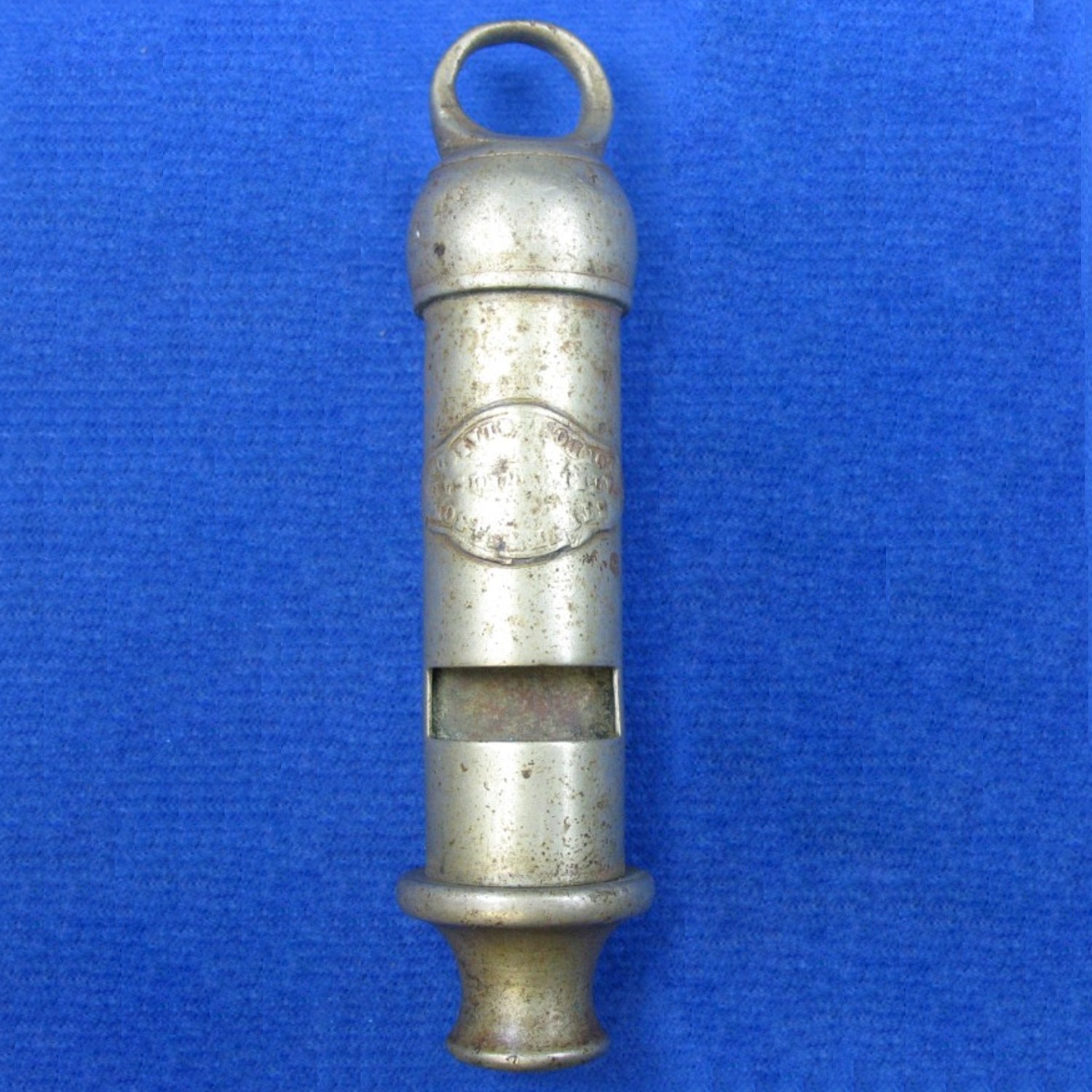
Bell shaped whistles are usually not marked as to Stevens and Son(s) and have proved difficult to date accurately. They do not have any direct attachment at this time to Richard Porteous as in an overlabel as he was fond to use. The slide whistle manufactured by Stevens during the mid 19th century we have not obtained to show a picture of. However letters of the day describe Porteous as designing a slide whistle and also an ‘acorn’ or bell whistle during this time period.
Gilchrist has the bells dated prior to 1870 ( see More Whistles 2005 ). They appear to be derived from and directed to the railway steam whistle shape and appropriately so as Stevens and Son from Glasgow to London were THE railway suppliers for decades in the mid 19th century with stamps such as West London and the rare but fortuitous bell whistle stamp Stevens and Son West London Railway, which helps to date this as pre 1870 and of Stevens manufacturing.
So with this proposed timeline, let’s look closer at more of the line of Porteous designs in whistles…
With thanks to Leif Bailey of the UK we are able to really see the beauty of the regimental field pipe in the pictures that follow, as we do not have as yet an example in the reference collection. It is now known that this design and manufacture would more accurately date back to the 1830s, predating what was previously thought – even the Wind Instruments of 1845 by over ten years.
First, the advertisement dated circa 1834. Here was a venture that would carry on for decades with Richard Porteous. The invention, design and sales of his own whistles. The field pipe was more of a musical instrument, but gave rise to his talent to invent and design whistles. What is also interesting is his full on advertisement bursting onto the retail and production scene with many distributors or agents like Distin and Sons and Kohler.
No patent or registration was filed as was done with 1845 Wind Instruments. Although the Field Pipe was available in brass, we have only seen nickel silver.
It would be a decade before he progressed into the impressive, railway signaling direction that would take him away from military and towards railway and police markets.
The Regimental Field Pipe for light infantry purposes was marketed for the military and quite a few military connections are revealed in his advertisement. His musical connections can be seen at the end of his advertisement. The pipe is rare, but is seen occasionally for sale. What his sales of the day and production levels were is unknown as is who actually manufactured them.
It is notable here that from the onset Richard Porteous had a very high standard for his whistle designs, for example his desire to be able to clean his ‘instruments’. Each had the ability to unscrew and be cleaned. This would be a theme he carried through all his whistles. He was a master designer following years of musical instrument study. Indeed the pipe is not a whistle and the Wind whistle is called an ‘instrument’.
Business records indicate that JJ Stevens was building his fledgling business on his father’s shoulders at the time of this advertisement OR his father was building a bsuines that his son would take over. Stevens were brass founders, true. But whether Stevens manufactured this whistle is unsubstantiated at this point. Likely not, as we note the craftsmanship and quality involved is more like a musical instrument. Indeed Gilchrist stated that it was one of his finest sounding whistles and he had over 5000 !!
Porteous Registered Wind Instruments made 10 years later would be bulky, heavy cast and somewhat rough comparably — if Stevens were used to manufacture even them is also tenuous. However there were various musical instrument makers of the day and one looks to them.
We also note here the label that would be a Porteous hallmark on all his smaller whistles. No mention of Stevens is seen on any early labeled whistles by Porteous. Fully 11 years before the multi pipe railway wind instruments, with the field pipe the leaning was towards the musical instruments of his background.
During the period from 1845 to 1860 two new designs that would change whistles would emerge. His multi-tube shaped whistle and single tube whistle with two windows, the first on record of their types and Richard Porteous clearly emerges as the creator of new designs in whistles that would set the stage for the future of all whistle manufacturing. Originally in his designs the mouthpiece was cast brass or in the case of Bells, ivory .
The entire mouthpiece of each size multi-tube whistle unscrews to reveal a tall standing tapered thick disc that would separate the air out the windows. In the 6 tube it is a cone, in the lesser tubes it remains flat.
The Porteous Wind Instrument was manufactured in three sizes ( as of 9-12-15 ) as the following picture reveals. In the following picture the four tube is shown side by side. The six tube has been found in one size only. It is equal in size to the middle size.
Following then is a picture of the three models known. It pictures the three models, which are of a three tube, four tube and six tube.
In his single tube the diaphragm is machined for a custom fit. His earliest whistles lacked a dividing wall between the windows that is called a partition. In other words you could see right through the windows.
Richard Porteous had designed his wind instruments of 1845 registration and there is a gap after that and before his whistles associated with Stevens and Son circa 1860s and later 1870s with the changed name of Stevens and Sons ( emphasis on the plural sons ).
This puts this whistle circa 1860 and likely pre Stevens manufacture.
Significantly this large tube shaped whistle without partition became a milestone in whistle history. — Eventually a similar whistle would be manufactured with a partition and would shrink in size eventually becoming iconic under the influence of Joseph Hudson as THE police type whistle body.
First seen in the following three pictures is the earliest known tube shaped whistle from the UK and clearly by Porteous as seen from the Label.
Next is seen Stevens and Son entry on the stamp and prior to 1870, as he states only one son.
Third is a later design, more simplified and post 1870, unmarked as to maker, but with, by now, Stevens unique unscrewable and machined mouthpiece/diaphragm.
Successively every few years the size was reduced in manufacture, although nickle silver was introduced and kept in production.
Successively the diaphragms and mouthpieces changed using cast and then machined parts .
Side by side the sizes can be seen. What really strikes one though is that circa 1860 there had not yet been designed a separating partition. Yes, there was merely one clear note, the split sound not creating the dissonant sound ( which would be so distinctive and synonymous with ‘bobbies’ ) of which was still in its infancy. So we are at…
stage one:
1) tube shaped design
2) no partition – one sound
Please take the time to peer inside the hollow 1860 design and then note the partition a few years later where the note was split in the pre 1870 design. Although the same lengths and the same note, we are now at stage two, circa 1865-69.
Stage two:
1) partition introduced
2) single sound, but split
3) dissonant sound. varied lengths of chambers
whether Stevens did it knowingly or accidentally, measuring the chambers reveals different lengths and thereby dissonat sounds ( also varied )
This change would have to wait for approximately another decade to be stabilzed for production and is credited to Joseph Hudson when he puposely varied the length of the two chambers, creating a dissonant sound that would finally become the sound so recognized today.
The ‘diaphragms’ remained essentially the same in design, although they also varied in size dramatically.
Timeline ?? — Post 1845 Porteous Wind Instrument
1850 – 60 – single tube shape emerges ( Porteous )
1865-70 – partition, splitting sound ( Porteous/Stevens ? )
same time – chambers vary
— Porteous retires late 1860s, early 70s ?? Passes away ten years later, 1881
1880 – Inside length varied, dissonant sound ( Hudson )
Features:
size reduces, earliest hourglass mouthpiece emerges, Stevens applies his name, bulbous top emerges, nickel silver used.
Interestingly Joseph Hudson left Bent and Parker in 1870 ( Gilchrist ) and started making whistles at St. Mark’s Cottages 17 St. Marks Street during the same period that Porteous left off.
1870 to 1882 during the same time Stevens was manufacturing whistles. Stevens had one outlet in London, Hudson centered in Birmingham.
During this earlier period ( i.e. 1845 ) a letters indicate that his whistles were being tested for change over from rattles to whistles in the Metropolitan Police Force – Actually the Wind Instrument is the one that, turns out was tested. Rather bulky for police work, but the rattle considerably more so. Letters show that at this time the rattle still prevailed as the call of choice. Significantly his whistles were having a notable impact though, which was inevitably to follow and supersede those rattles.
The Metropolitan Police force was established in 1829 by Robert Peel from whom we get the nickname ‘bobby’ and the following excerpt to James Graham appointed to Home Security helps to establish just how early Porteous influence was involved in police whistle use. Here is an excerpt from a superintendent’s report sent on by Charles Rowan…
“whistle, invented by Porteous ( i.e. 1845 Wind Instrument )should be used by the whole police force. Enclosed in the first letter are copies of the superintendent’s report on the trial of the whistles and a letter by Charles Gregory, Engineer to the London & Croydon Railway Company ( who invented the first railway signaling device that later Stevens would be known for improvements of) …”
This was from Charles Rowan who was appointed as a Justice of the peace in 1829 in charge of the force along with Richard Mayne his eventual successor. Charles Rowan retired in 1850 and died two years later of colon cancer. No doubt Rowan’s military background lent to his desire to see whistles used on the para-military police force.
So dating these records would fall between 1845 ( registration of the wind instrument ) and 1850, Rowans death.
It was referring to the bulky wind instruments, and has mentioned they failed to replace rattles of the day. Eventually the tube shaped smaller whistles would become the preferred call. When his very earliest designed tube whistle was designed and manufactured is a ‘missing link’ in whistle history. However it does appear to be the earliest design of its type — that would eventually be copied, improved and rose to the iconic level that Hudson would achieve in the early 1880s.
So what have we learned ?? That Richard Porteous was a gifted and prolific whistle designer of the 19th century dating back to the 1830s. Perhaps he was one of the best. His knowledge of music and the dynamics in structure of wind instruments enabled him to be innovative with :
Multi note pipes
Multi tube ( railway, sporting, police, hunting )
Tube shaped ( police, railway, general service )
Sliding ( dog training ) – only one seen to date
Rounds ( railway, police, general )
Bells ( railway )
‘Porteous’ tops tube shaped ( various uses )
And that he was not only creative, but that he had very high standards. It becomes evident in that the quality he incorporated, required machining — at much extra cost and effort. We see that he desired that all his whistles be able to be unscrewed and cleaned– a design that would be used only in the finest whistles to follow him.
What have we yet to look for ?? Some provocative questions follow…
–What actual year was the tube shaped ‘police’ whistle design by Porteous ??
–What exactly was the connection between Richard Porteous and J. J. Stevens and when did it begin ??
–Are there any other designs of whistles by Richard Porteous ??
( one letter describes him working on a whistle that would work for 3 or 4 dogs, better than the slider )
Update:
A beautiful example of a cosh ( or black jack ) was contributed and we would like to publish it here for the first time. The following is a letter and the accompanying pictures.
Dear Len
I am semi-retired at the age of 68, and came across The Whistle Gallery about two years ago….
TWG has encouraged me to collect a few whistles , and to look out for the rarer ones. Several months ago while surfing the net …I came across a whistle attached to a cosh or sap, and described by the auction house as a Victorian “Porteous Life Preserver”. I got very excited knowing its rarity, as no whistle by Richard Porteous has been seen to be attached to a cosh on any of the whistle sites.
The cosh is flexible with a lead weight attached to the end. Both cosh and whistle are in very good condition. The whistle can be unscrewed in two areas for cleaning and replacement of the pea, and the two windows are in line with each other.
Should you wish to add further information to the spotlight on Richard Porteous using the enclosed photos etc, please feel free to do so… All the best Len to you and TWG.
Yours sincerely, Gareth Edwards
Many thanks Gareth !!
This article took many months of research and of course time ( and cost ). We still have material coming, but did not want to hold back from sharing with you what had surfaced. As with the marvelous 6 tube we just published on our SPOTLIGHT – special edition, we will continue to add what we find to the growing field of whistle history and research as addendums. In the mean time, this re-write.
We will incorporate and post anything further as it arises. Please feel free to write and ask for clarification, if we have written out of context or missed anything. We also invite any challenges for dating or describing anything wrong, we all want to be accurate. The wonderful thing about the internet over written books is that corrections can be made and updated instantly and no books to follow.
TWG
Posted December 15, 2015
